Posts Tagged henry ford museum
A Lesson in Safety: Salt Walther’s Race Car

The mangled wreck of driver David “Salt” Walther’s 1972 McLaren M16A is on exhibit in Driven to Win: Racing in America in Henry Ford Museum of American Innovation.
Search the 1973 Indianapolis 500 on the Internet, and you won’t find a bunch of happy headlines. Words like “fatal,” “tragedy,” “cursed,” and “unforgettable” pop up.
Three deaths and multiple crashes are attached to the ill-fated race. One of the day’s most dramatic headlines, and still considered one of the worst crashes in Indy 500 history, involved driver David “Salt” Walther and his 1972 McLaren M16A, an artifact on display in Driven to Win: Racing in America in Henry Ford Museum of American Innovation.
On the race’s first lap, Walther’s car crashed into the outside wall, exploded, and overturned. Images of the ripped-apart vehicle with Walther’s feet dangling outside of it are disturbing, but although badly burned, Walther did survive the accident. Miraculously, he didn’t lose his passion for auto racing either, coming back to the sport to drive again in 1974. In fact, Walther started in seven Indianapolis 500s, five of which occurred after his terrible crash (his best finish was ninth place in 1976).
Continue Reading
Indiana, 20th century, 1970s, The Henry Ford Magazine, racing, race cars, race car drivers, Indy 500, Henry Ford Museum, Driven to Win, cars
Crispus Attucks and Evolving Perceptions of the Boston Massacre
 “The Bloody Massacre,” 1770, engraved by Paul Revere and hand-colored by Christian Remick. / THF8141
“The Bloody Massacre,” 1770, engraved by Paul Revere and hand-colored by Christian Remick. / THF8141On March 5, 1770, in King Street in Boston, Massachusetts, several British soldiers fired into an angry group of civilians who had been taunting them. When the shooting was over, five of these civilians lay dead or dying. The first to fall, it is believed, was a man of African American and Native American heritage named Crispus Attucks.
The event, which soon became known as the Bloody Massacre, or—over time—the Boston Massacre, incensed Bostonians to such an extent that it came to be considered a defining moment in the lead-up to the American Revolution.
The more than 200 eyewitness accounts that were collected afterward agreed on some points but disagreed on many others. In the end, we have only impressions, fragments, and often competing narratives of what people remembered seeing. The sequence of events might have gone something like this: The initial angered group approached a guard in front of the Customs House and started insulting him and pelting him with snowballs and chunks of ice. The situation quickly escalated as the crowd grew larger. The guard called for reinforcements. Other British soldiers, including a captain, arrived. More townspeople joined in, throwing snowballs and insults at the troops. A soldier was knocked to the ground. He stood up, yelled, and fired his musket into the crowd. Then several other soldiers fired their weapons, killing three and mortally wounding two others.
Perhaps this is the sequence of events. We will never know for sure.
Whatever people thought they saw, almost immediately the popular press took full advantage, describing the event in endless detail and hailing the fallen victims as martyrs in the fight for liberty. Even the use of the word “massacre” implied a premeditated, cold-blooded, intentional act by British soldiers against American patriots.
This event did not occur in isolation but was an outgrowth of months of increasing tension between the British and Boston civilians, who were angered by the relentless passage of new British-imposed taxation laws. In 1768, British soldiers had been deployed to Boston to try to maintain order there.

“A View of Part of the Town of Boston in New-England and British Ships of War Landing Their Troops!” 1768, engraved by Paul Revere and hand-colored by Christian Remick. / THF11644
In fact, the angry individuals who had initially taunted the soldiers were not patriotic Sons of Liberty but working-class day laborers, apprentices, and merchant sailors. These individuals had a particularly personal gripe against the British soldiers: the soldiers, who were poorly paid, often competed with them for jobs, and this competition inevitably led to lowered wages.
In the end, it didn’t matter that the initial crowd who started the fracas was motivated more by economic reasons (jobs, wages) than ideological ones (liberty, independence). Nor did it matter that John Adams’ brilliant defense of the soldiers eight months later in court played to the jury’s prejudices against race and class by labeling the angry crowd as an unruly mob of young, lower-class, Black and Irish sailors. Bostonians were riled up. And the fact that all but two soldiers were acquitted at the end of their murder trial further inflamed them.

Engraving of “The Bloody Massacre,” created about 1800 from the original 1770 Paul Revere print, showing a clearer depiction of the Butcher’s Hall sign than the hand-colored lithograph shown at the beginning of this post. / THF130817
One Boston patriot, engraver Paul Revere, decided to use this event to make a larger political statement (for more on Paul Revere, see “Paul Revere and The Henry Ford's Tie to Tea”). Basing his engraving upon an as-yet-unpublished rendering created by artist Henry Pelham, Revere was able to complete his own engraving ahead of Pelham’s and start disseminating a mere three weeks after the event. He gave it the dramatic title, “The Bloody Massacre: Perpetrated in King Street, Boston on March 5, 1770, by a party of the 29th Regt.” This title ensured that the focus would be on the shooting, the place, and particularly on the “guilty”—i.e., the soldiers.
Revere cleverly heightened other details to make certain points—the orderly lineup of British soldiers firing into the American crowd, their actions depicted as brutal and deliberate; the colonists dressed as gentlemen rather than laborers, their behavior seen as innocent and defenseless; and, above the soldiers’ heads, a sign reading “Butcher’s Hall,” rather than the actual Customs House, to underscore the goriness of the event. All of these details—and more—were, in fact, inaccurate and misleading. But they certainly shaped public opinion. The narrative told within this print would endure for centuries—even to the present day. It was possibly the most effective piece of war propaganda in American history.
Noticeably absent in Paul Revere’s engraving is the aforementioned Crispus Attucks—generally thought to be the first casualty of the Boston Massacre. The reason for this? Likely, depicting a mixed-race, working class, itinerant sailor from out of town would not have played to the public sentiment that Revere was aiming for. Only later did Attucks emerge as the most famous of the five victims of the Boston Massacre.
What do we know about Crispus Attucks? Admittedly, not much. Historians believe he was born of an enslaved African American father and a Native American mother. He spent his early life enslaved to a man in Framingham, Massachusetts. At age 27, it is believed, he ran away (about 20 years before the Boston Massacre) and was never apprehended (he might have changed his name to avoid detection). An ad for a runaway slave that was possibly Attucks described him as 6’2”, with short, curly hair and a robust physique.
He apparently made his way to Boston, where he sought work as a sailor (one of the few trades open to non-whites), spending most of his time on whaling ships, and when on land, was a rope-maker (a typical dockside job for sailors). He was often at sea, and on this particular day, March 5, 1770, he was waiting for an opportunity to ship out. Not only could his anger at the British soldiers have been due to job competition, but he, like other merchant sailors, also faced the danger of being forcibly impressed into the British Royal Navy (for more on the lives and risks of African American merchant seamen, see “Piecing Together Black History: A Case Study”).
Accounts vary widely as to Attucks’ role in the Boston Massacre. Was he a leader and instigator of the angry crowd, as some claimed? Did he step into the fray, swinging a stick and grabbing a soldier’s bayonet, as others described? In defending the British soldiers, John Adams sought to distance Attucks (and the other so-called “rabble-rousers”) from the upstanding, respectable, solid citizenry of Boston. He described Attucks’ behavior as “mad” and declared him the self-appointed leader, chief to blame for the “dreadful carnage.” Other testimonies claimed he was not the leader or an instigator, but stood off to the side, watching the melee unfold. Rather than angrily wielding a stick, he was quietly leaning on one.
Most people at the time considered him—along with the other fallen victims—a martyr, a hero. Breaking with usual segregation customs, Attucks was accorded an honored burial alongside his fallen comrades at the Granary Burying Ground on Tremont Street. Burial rites for the victims, held at Faneuil Hall days later, reportedly attracted some 10,000 of Boston’s 16,000 citizens.

When seen through a special viewer, the two pictures in this stereograph give a three-dimensional effect. This circa 1859 stereograph is of Faneuil Hall, the public meeting hall that was the site of the burial rites for the Boston Massacre victims back in 1770. / THF278882
Several decades later, Attucks was recast as the central figure of the conflict. During the decades before the Civil War, anti-slavery advocates memorialized him in order to garner support to end slavery—calling him the first martyr in the fight for American independence.

The anti-slavery press, centered in northern states like New York and Massachusetts, produced and sold almanacs like this one that featured provocative cover illustrations depicting the brutality of slavery. / THF7209
In 1855, in direct contrast to Revere’s earlier engraving, artist William L. Champney featured Attucks in a brand-new rendering of the Boston Massacre, placing him at the very center of the conflict. The rendering was turned into a popular color print by J. H. Bufford.
In 1888, a monument (still standing today) was unveiled in Boston Common honoring all five victims of the massacre, but it focused attention on Attucks and was ever after referred to as the Crispus Attucks Monument. During the Civil Rights movement of the 1950s–1960s, Attucks became a powerful symbol of African Americans’ struggle for freedom and equality. In his seminal 1964 book Why We Can’t Wait, the Reverend Dr. Martin Luther King, Jr. reinforced the symbolic role of Crispus Attucks:
He is one of the most important figures in African-American history, not for what he did for his own race but for what he did for all oppressed people everywhere. He is a reminder that the African-American heritage is not only African but American and it is a heritage that begins with the beginning of America.

Cover of Dr. Martin Luther King’s 1964 book, which contains the reference to Crispus Attucks. / THF266487
In recent years, Attucks’ role in the Boston Massacre has been reimagined again, this time as the first African American victim of unrestrained police brutality.
The role that Crispus Attucks played in this event was debated from the beginning. Was he the leader of an unruly mob angry about jobs? Was he a hero and a martyr, fighting for liberty? In fact, his most important role may be that of showing how perceptions of individuals can change over time. As historians and curators continue to sift through the documented details about the Boston Massacre, interpretations will change. But the power of this dramatic event, and the meaning people find within it, will endure.
Donna R. Braden is Senior Curator and Curator of Public Life at The Henry Ford. This blog post is part of a series that sheds new light on stories told within the With Liberty & Justice for All exhibition in Henry Ford Museum of American Innovation.
African American history, Henry Ford Museum, by Donna R. Braden
Quiet & Loud Protest
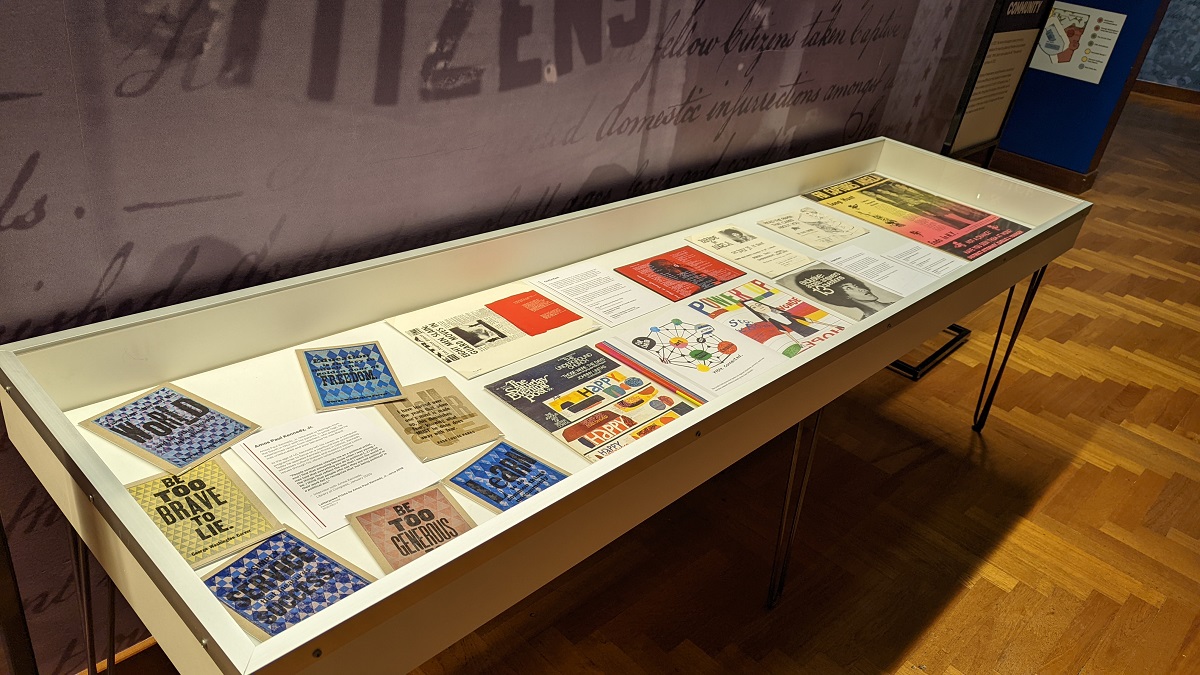
Photo by Curatorial Staff of The Henry Ford
When you think of the word “protest,” what does it mean to you?
- Marching at a rally with a sign?
- Participating in a “walk out” at school?
- Boycotting companies?
- Wearing a shirt or hat with a message?
- Correcting people on their biases?
- Donating money to organizations?
- Civil disobedience?
A new temporary exhibit now on view in Henry Ford Museum of American Innovation, Quiet & Loud Protest, explores this question by demonstrating the ways that protest can be both loud and quiet. Throughout history, people have found different ways to advocate for change, whether marching in the streets or finding quieter ways to be an ally. Both are valuable in drawing attention to injustices. The exhibit draws together a small selection of recent acquisitions that showcase how artist-activists have used graphics to demand change and organize communities. The content of the exhibition is replicated in this post (with slightly expanded descriptions) for those unable to see it in person.
Amos Paul Kennedy, Jr.
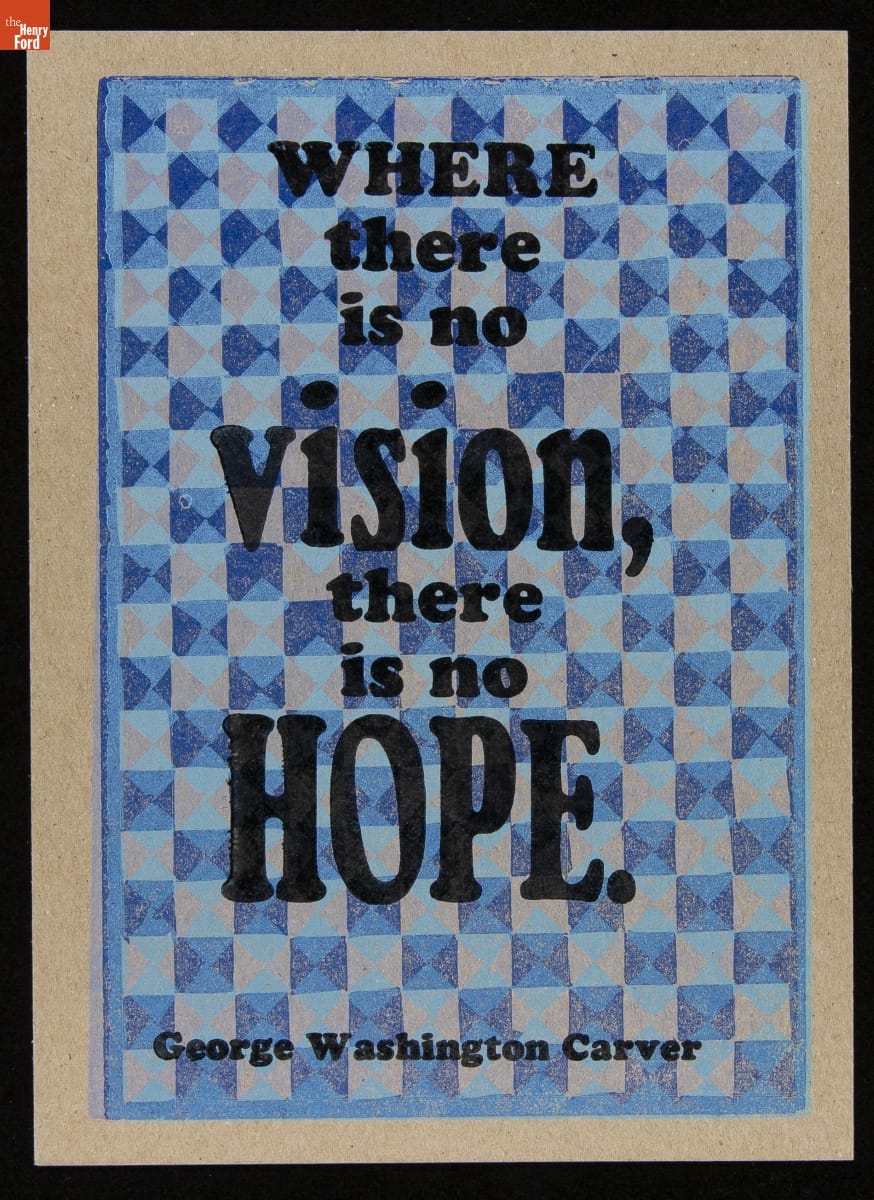
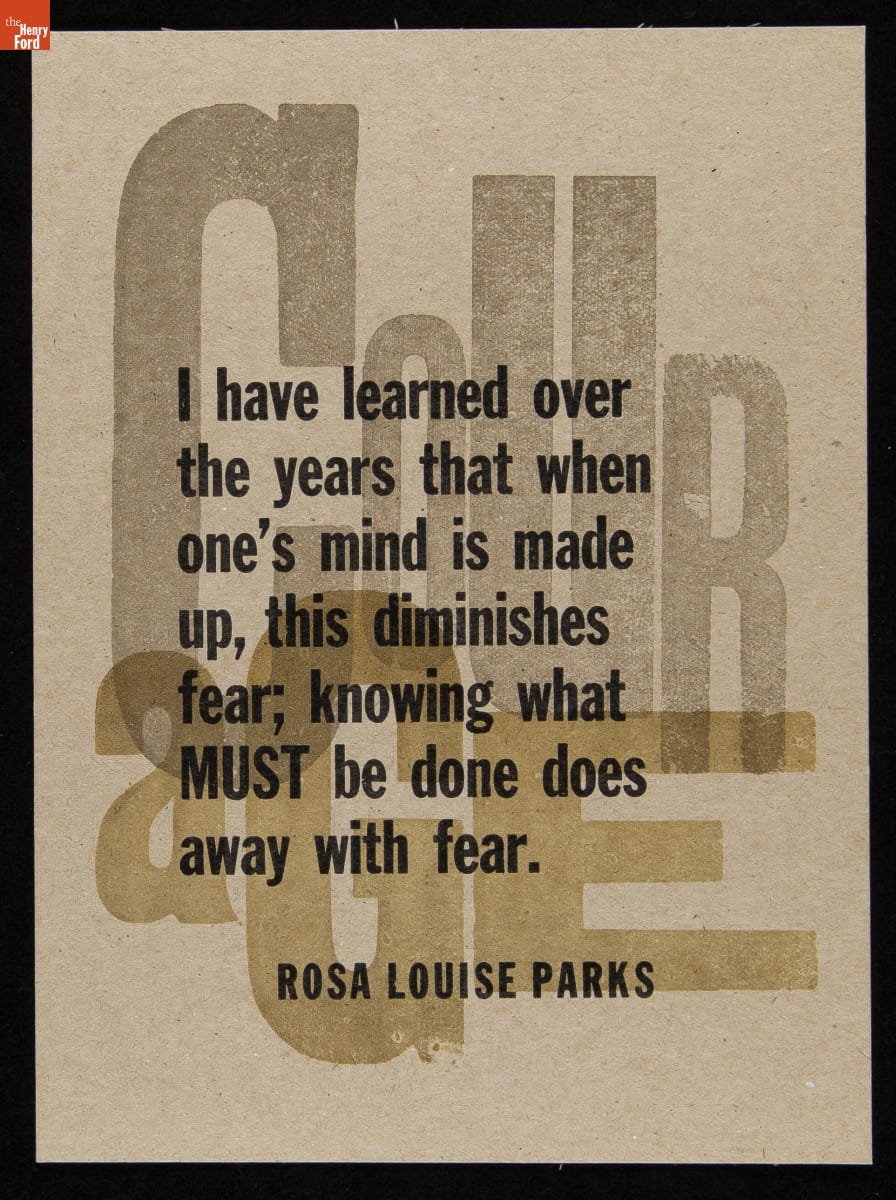
Amos Paul Kennedy Jr. has generously donated several prints to the collections of The Henry Ford. These examples feature quotes attributed to George Washington Carver and Rosa Parks—two advocates for change who are prominent in our collections. / THF626953 (top), THF626939 (bottom)
These letterpress prints are by Amos Paul Kennedy, Jr., who relocated to Michigan from the South in 1963 with his parents. In junior high, he experienced racism from teachers who presumed he was uneducated and poor because he was Black.
At the age of 40, Kennedy visited Colonial Williamsburg while on vacation with his family and was so enamored with the letterpress and bookbinding demonstrations being given by historical reenactors that he went home and began to take classes at a community print shop. His love for the medium grew to the point where he made the decision to leave his career as a corporate computer programmer at AT&T so that he could focus on printmaking full time.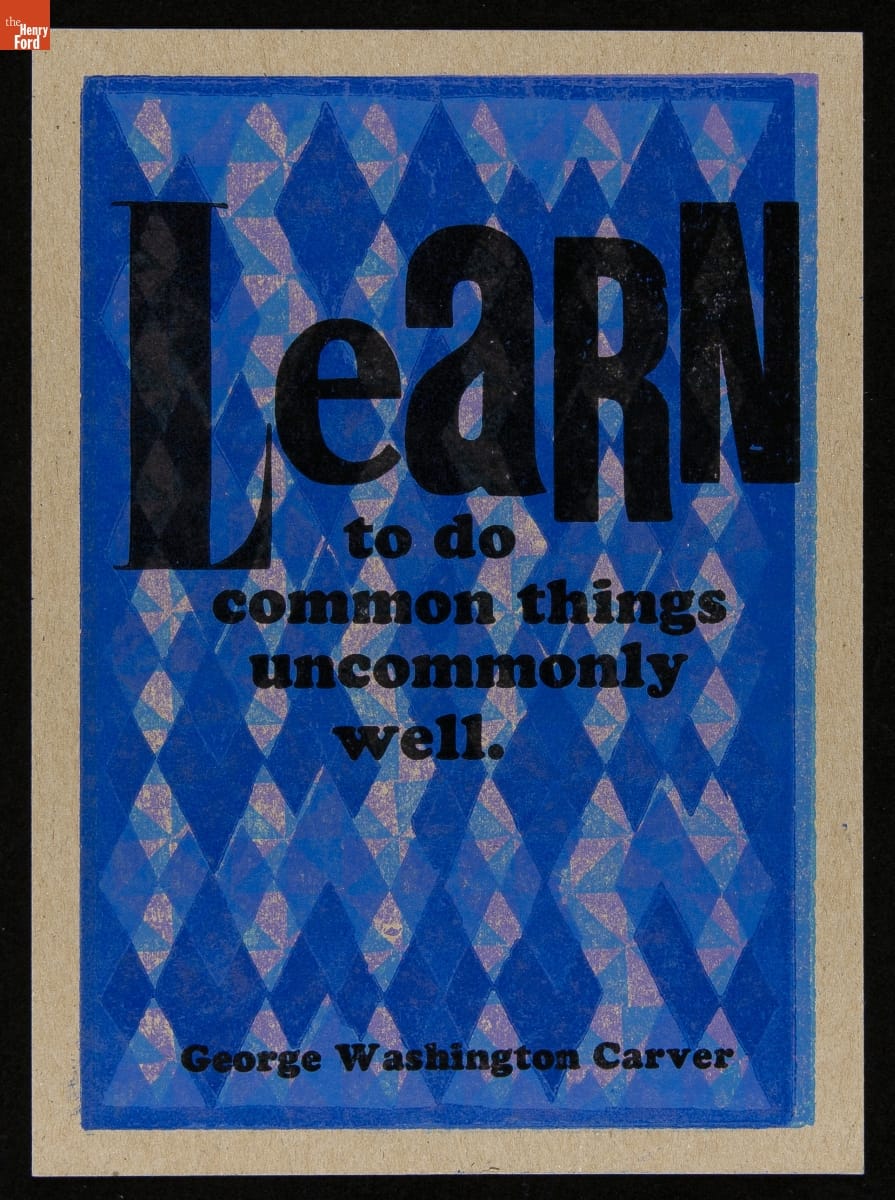
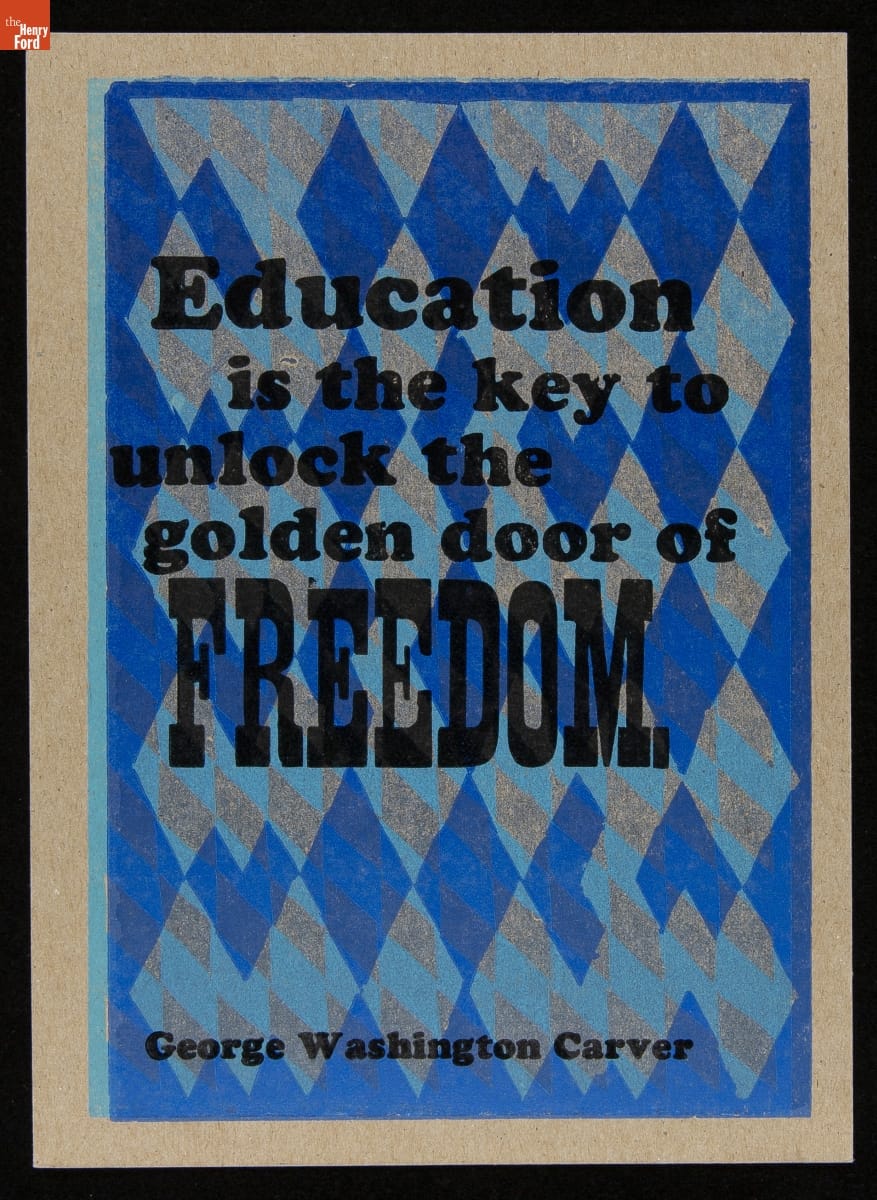
Letterpress prints by Amos Paul Kennedy, Jr./ THF626947 (top), THF626949 (bottom)
He went on to earn an MFA in Fine Arts and taught in university art programs. When Kennedy left academia, he adopted the historical role of an iterant printer, travelling through the American South to different print shops, learning about print media and developing his style over the course of many years. Kennedy sometimes describes himself as a “humble Negro printer” and wears bib overalls with a pink dress shirt. By doing this, Kennedy confronts people with their biases, causing them to question race, language use, and class. In 2013, Kennedy moved to Detroit, where he operates Kennedy Prints today.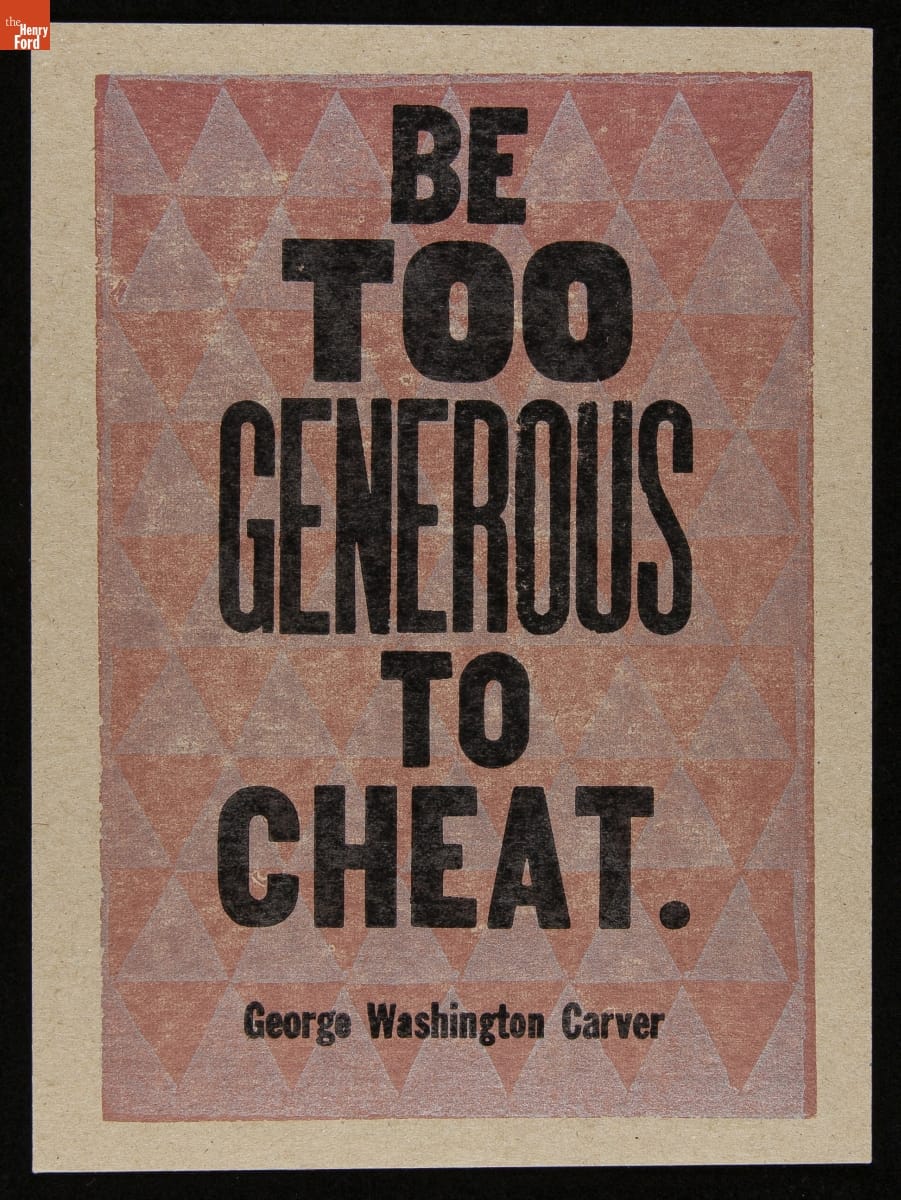

Letterpress prints by Amos Paul Kennedy, Jr. / THF626943 (top), THF626941 (bottom)
Kennedy is known for his prolific output of vibrant letterpress prints that address cultural biases and social justice issues. Many of his prints feature quotes by Black civil rights activists and abolitionists, scientists and innovators, and literary figures, as well as traditional African proverbs. In an interview with the Library of Congress in January 2020, Kennedy said:
“People sometimes classify me as a political artist, and I find that amusing because when I was young, I was told that everything you do is political […] I print the things that reflect the way that I want the world to be. I think that people who say they are not political in their work fail to recognize that ‘not being political’ is a political act.”
Kennedy refuses to call himself an artist and sells his work at affordable prices to make it more accessible. Thanks to the power of the multiple, Kennedy can use printmaking to spread messages of hope widely—to reflect exactly the type of world that he wants to live in.
Corita Kent
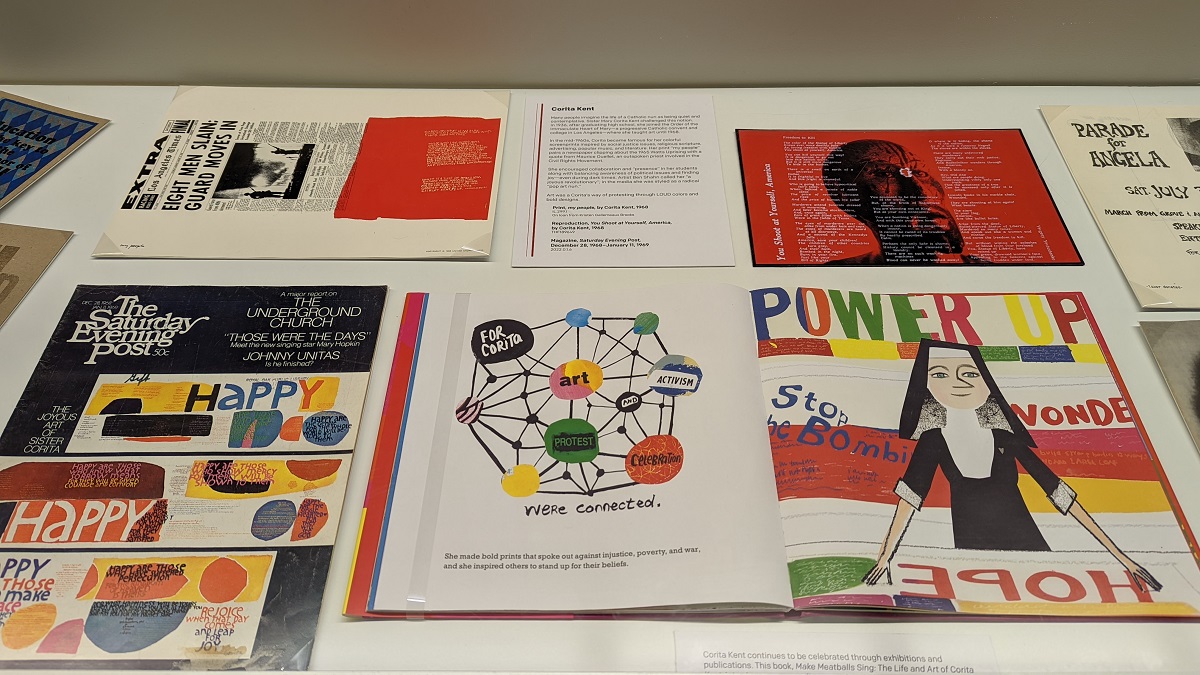
Photo by Kristen Gallerneaux
Many people imagine the life of a Catholic nun as quiet and contemplative. Sister Mary Corita Kent challenged this notion. In 1936, after graduating high school, she joined the Order of the Immaculate Heart of Mary—a progressive Catholic convent and college in Los Angeles—where she taught art until 1968.
In the mid-1960s, Corita became famous for her colorful screenprints inspired by social justice issues, religious scripture, advertising, popular music, and literature. Her most celebrated prints are text-heavy and vibrant, layering blocks of bright color and DayGlo ink with high-key photographic imagery and words that twist around the page.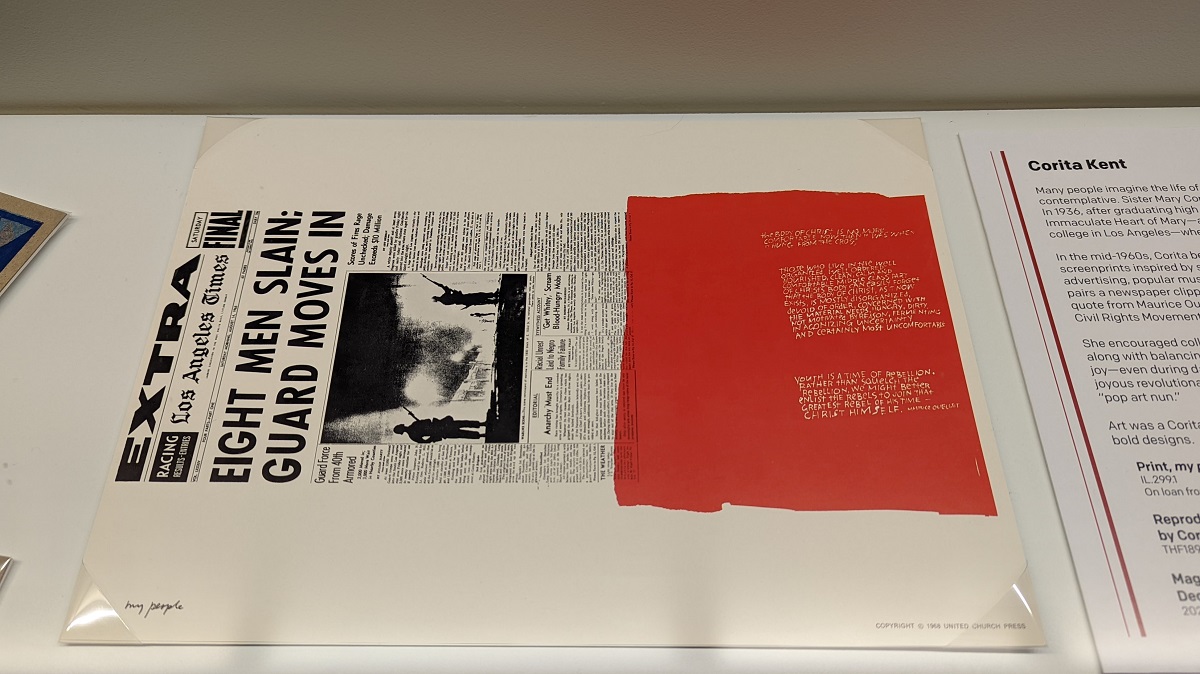
Detail of Quiet & Loud Protest exhibit with Corita Kent’s “my people” print. / Photo by Kristen Gallerneaux
Her print “my people” pairs a newspaper clipping about the 1965 Watts Uprising with a quote from Maurice Ouellet, an outspoken priest involved in the Civil Rights Movement in Selma, Alabama. Part of the quote Corita included reads: “Youth is a time of rebellion. Rather than squelch the rebellion, we might better enlist the rebels to join that greatest rebel of his time—Christ himself.” And in an oral history, Corita herself said: “I feel that the time for physically tearing things down is over. It’s over because as we stand and listen, we can hear it crumbling from within.”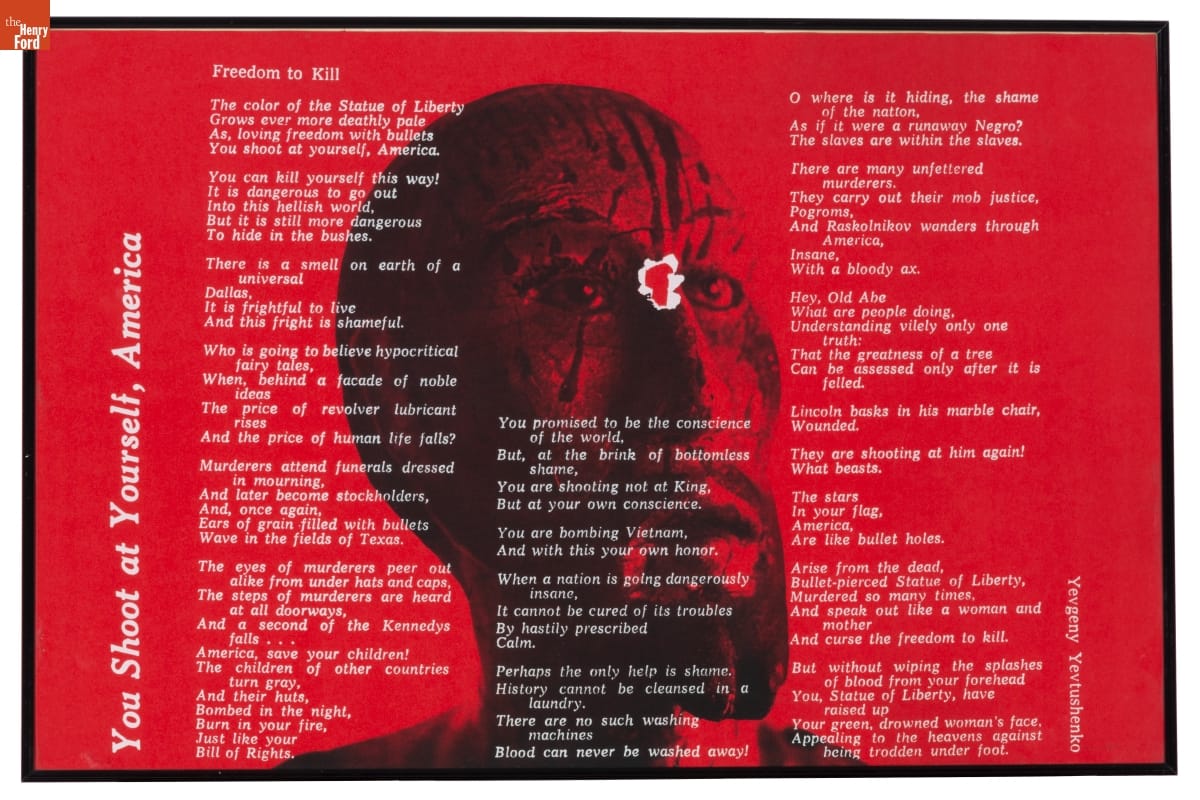
Corita Kent’s print “You Shoot at Yourself, America” was created in response to the 1968 assassination of Robert F. Kennedy. It features a poem by Yevgeny Aleksandrovich. / THF189649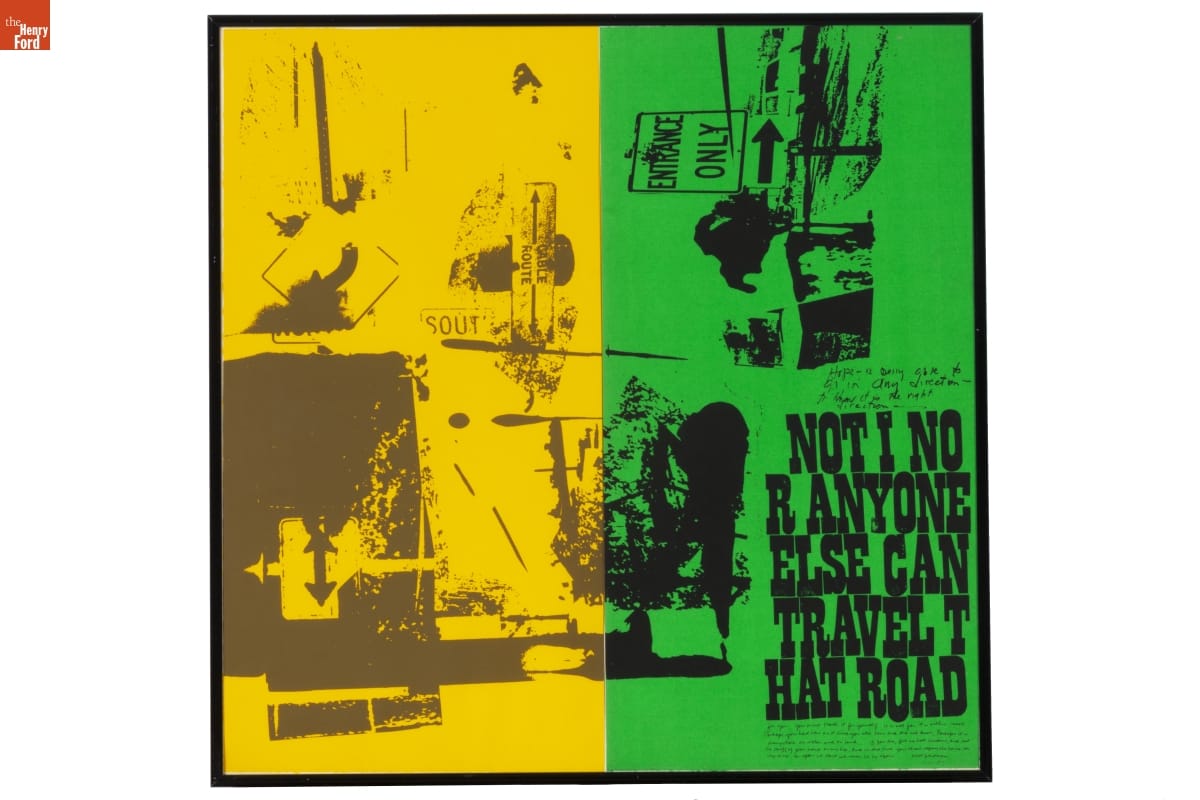
Corita Kent’s print “Road Signs (Part 1 & 2)” features text excerpted from Walt Whitman’s Leaves of Grass. / THF189650
Corita encouraged collaboration and “presence” among her students and encouraged them to balance awareness of political issues with finding joyful moments—even during dark times. Many important designers and creative thinkers visited her classroom, including Buckminster Fuller and Charles and Ray Eames. Artist Ben Shahn once called her “a joyous revolutionary” and in the media she was styled as a radical “pop art nun.”
Art was a Corita’s way of protesting through LOUD colors and bold designs.
During the height of Corita’s fame, the Catholic Church was reassessing many of its traditions, striving for unity and modernization under Vatican II. And yet not everyone agreed. In 1967, the Los Angeles archdiocese and Archbishop James McIntyre claimed the Immaculate Heart Community’s (IHC’s) approach to education was “communist” and referred to Corita’s work as being “blasphemous.” When the IHC sisters were ordered to end the liberating “renewal innovations” they had come to enjoy—or be asked to leave their teaching posts—many asked to be released from their vows and left in protest.
Corita’s decision to leave the order came a little sooner. In 1968, exhausted from an intense schedule and censorship from the church, Corita took a sabbatical. At the end of her time away, she left the Order and moved to Boston. There, she continued to receive commissions and to create art such as painting the Boston Gas Company’s tanks and designing the iconic “Love” postage stamp.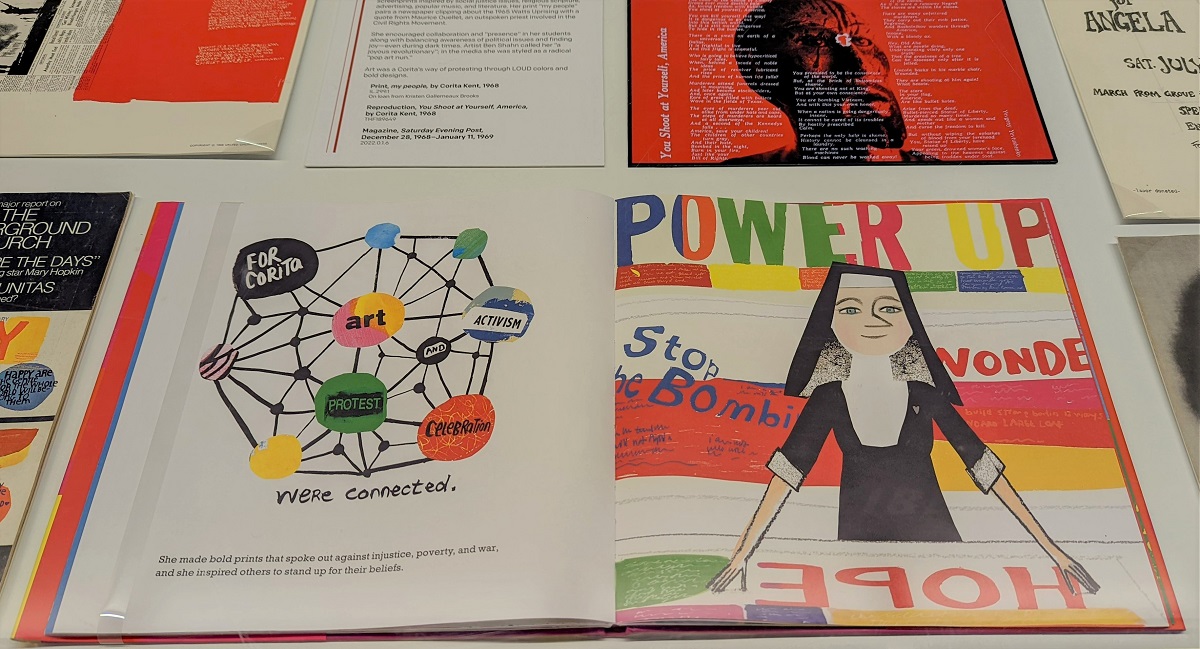
Corita Kent continues to be celebrated through exhibitions and publications. This book, Make Meatballs Sing: The Life and Art of Corita Kent, introduces young audiences to her story. / Photo by Kristen Gallerneaux
Angela Davis
Angela Davis is an activist, educator, and scholar who was a member of the Communist Party USA and the Black Panther Party. In 1970, Davis was placed on the FBI’s “Most Wanted” list. Guns registered to her name were used in a fatal attempt to free the Soledad Brothers during a courtroom trial. Davis was not present at the event. She fled police, fearing unfair treatment. After her capture, she spent 18 months in prison until being cleared of charges.
For some people, Davis is a controversial figure who believed in non-peaceful protest. To others, she is an inspiration as an outspoken supporter of women’s and civil rights, prison reform, and socialism. In recent years, she came out as lesbian and advocates for LGBTQ+ rights as well as those of Palestinian people.
The following artifacts relate to the impact of Angela Davis’s activism, past and present..jpg?sfvrsn=cc0a3601_2)
Vermont S. Galloway—a WWII veteran—made this “FBI Captures Angela” screenprint at Westside Press to advocate for Davis’s freedom. Galloway was fatally shot by the Los Angeles Police Department in 1972. / THF277084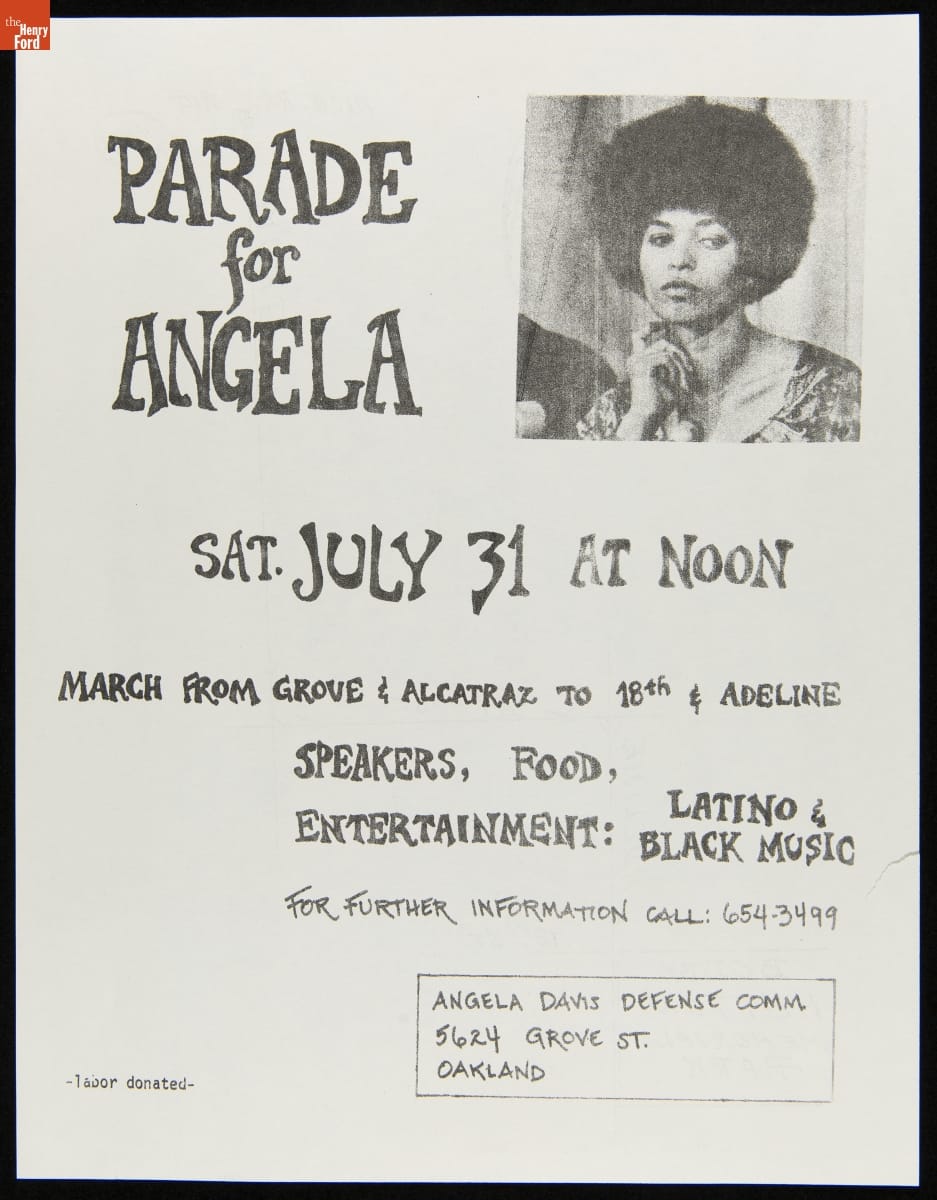
A parade flier documents the international “Free Angela” movement. The reverse side shows the planned route through Oakland, California. / THF627614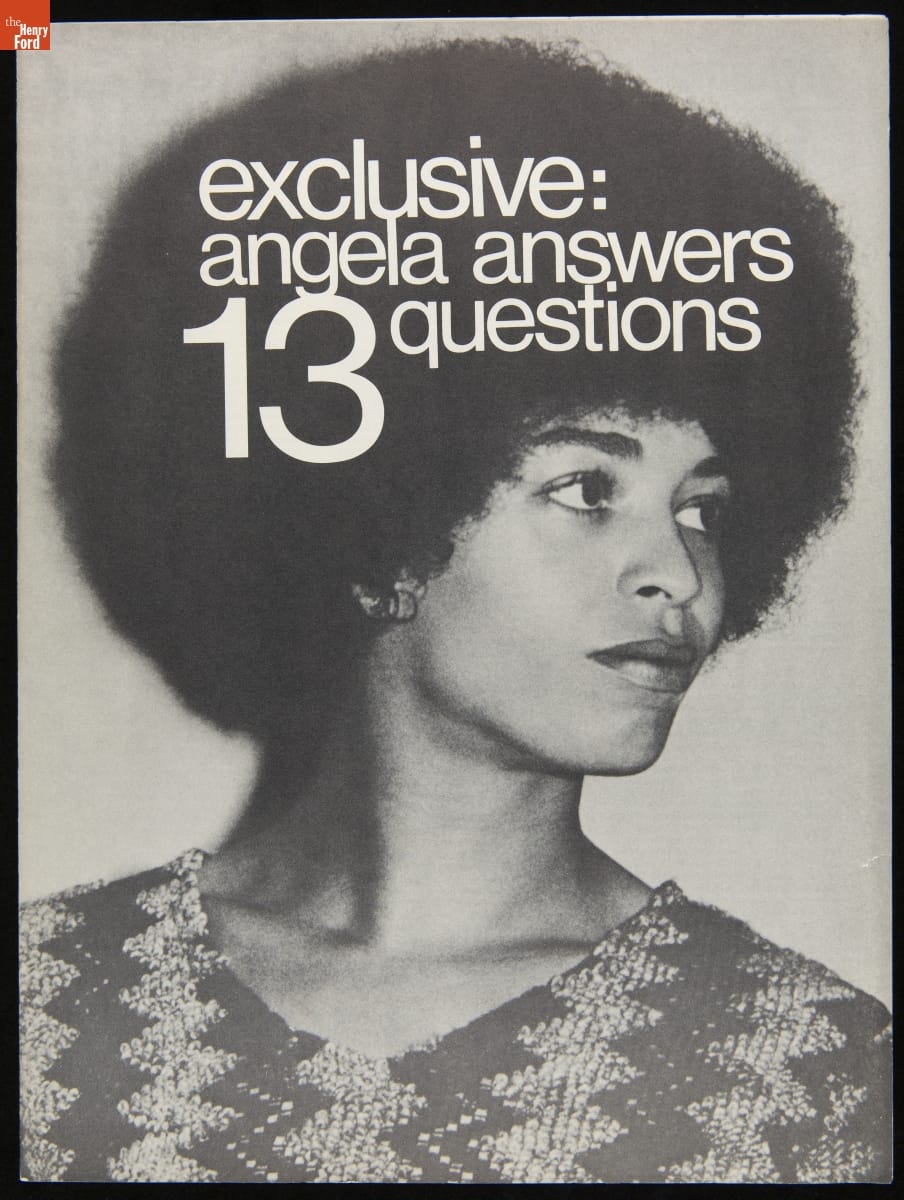
“13 Questions…” was the first interview with Davis while she was incarcerated. Her discussion with Joe Walker covers topics such as the surveillance of Black people, legal corruption, solidarity, and dismal prison conditions. / THF627594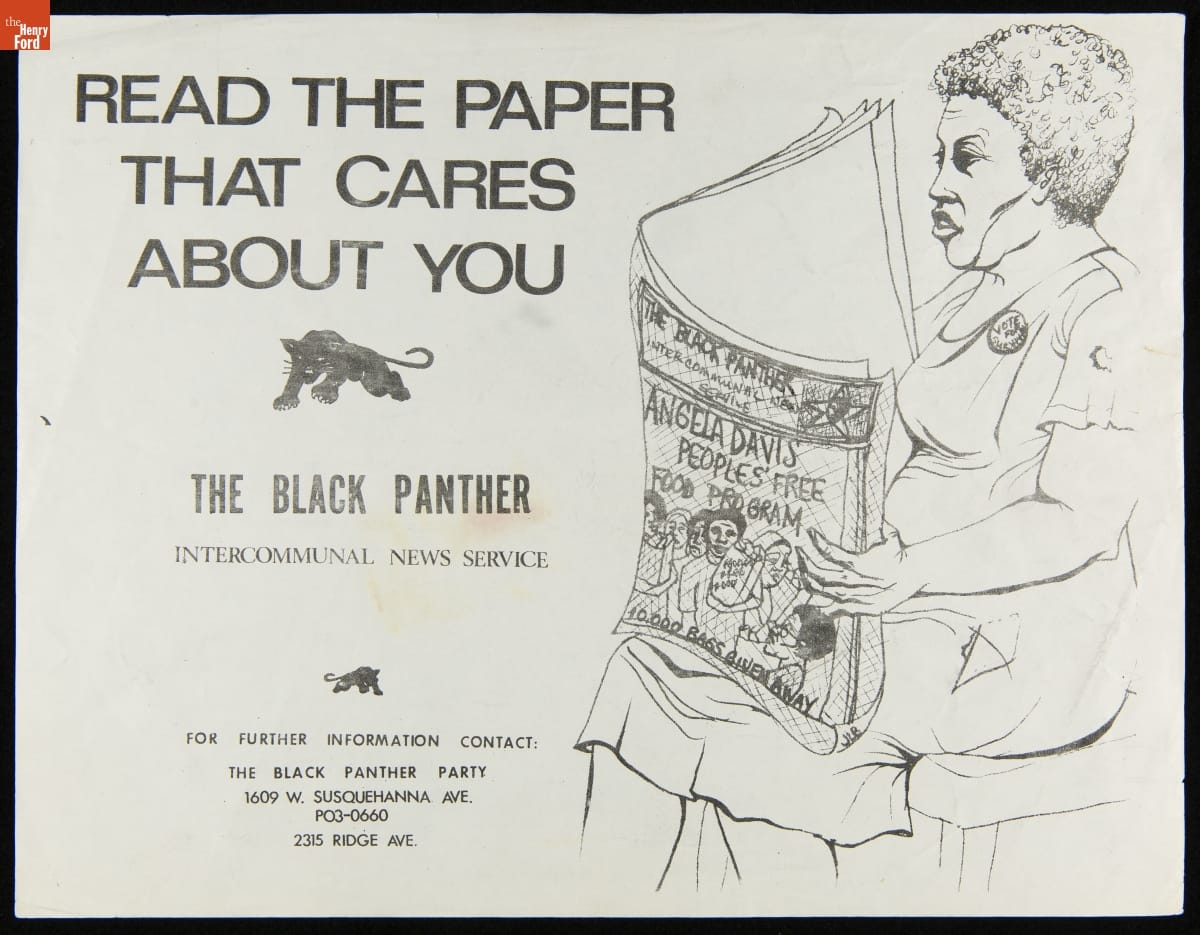
An illustration by Akinsanya Cambon advertises the Black Panther Party’s newspaper and the “Free Breakfast for Children Program,” using Davis’s name. / THF627598.jpg?sfvrsn=c40a3601_2)
Davis appears in a poster by Tongva artist Mer Young for the Amplifier Foundation. This poster shows the continued impact of Davis’s legacy and was created to encourage Black and Indigenous voting in the 2020 election. / THF626361
Listening to Our Community
In 2021, The Henry Ford began to seek community feedback for ways to update and improve our permanent exhibit With Liberty and Justice for All. This work is continuing in 2022.
Stories of movements, social innovators, and political history are difficult to fully capture in museum labels. There is always too much to tell in 100 words or less. To address this, throughout the display of this exhibit, we will be inviting several community partners to contribute their own labels, in their own voices, to foreground the issues they believe matter the most.
By the Curatorial Staff of The Henry Ford. Quiet & Loud Protest is on view in Henry Ford Museum of American Innovation until March 31, 2022.
Civil Rights, art, making, women's history, African American history, Henry Ford Museum, printing
The Deleted Slavery Passage from the Declaration of Independence
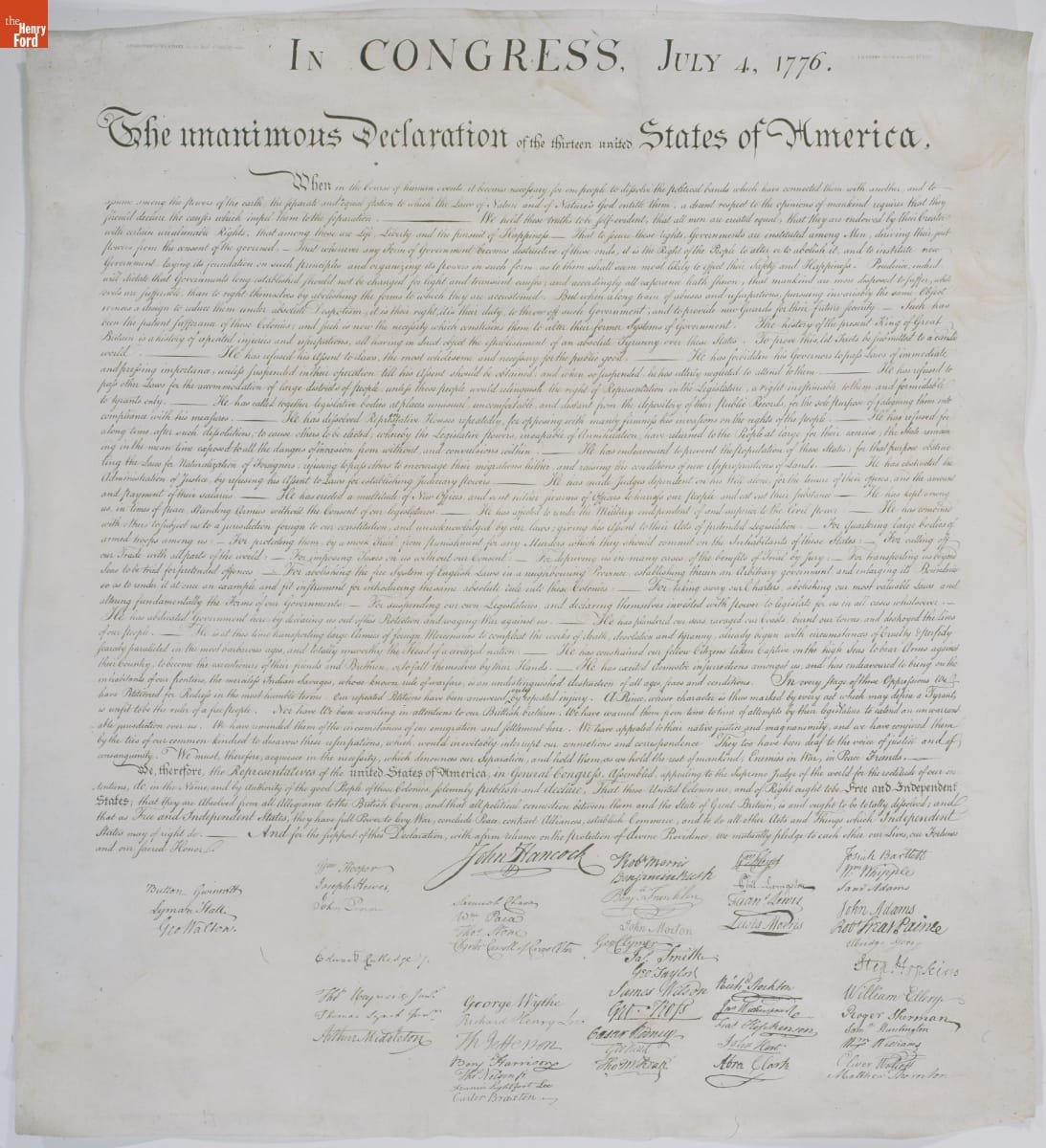 Engraved copy of the Declaration of Independence, one of only 200 copies commissioned by then-Secretary of State John Quincy Adams, printed 1823. / THF149572
Engraved copy of the Declaration of Independence, one of only 200 copies commissioned by then-Secretary of State John Quincy Adams, printed 1823. / THF149572
The Declaration of Independence, formally adopted on July 4, 1776, by members of the Second Continental Congress, was America’s manifesto against British tyranny. Thomas Jefferson, a Virginia delegate to the Continental Congress (and eventually a U.S. president), had been charged with composing the draft of this document.
Most people are familiar with these iconic lines from the Declaration of Independence:
…We hold these truths to be self-evident, that all men are created equal, that they are endowed by their Creator with certain unalienable Rights, that among these are Life, Liberty and the pursuit of Happiness…
This is the statement that is most memorable. It is the passage that has been invoked repeatedly throughout our history as a call to action, the passage that is still referenced today as the rationale for upholding people’s individual rights.
But there is much more to the Declaration of Independence than these lines. Further down, within a lengthier portion of the document, Jefferson’s initial draft included a scathing denouncement of slavery. If this passage had been retained, our country’s history might have been very different. But it was deleted.
Why did Jefferson—a slaveholder himself—write this passage denouncing slavery, why was it deleted, and what was the long-term impact of that decision?
The Slavery Passage
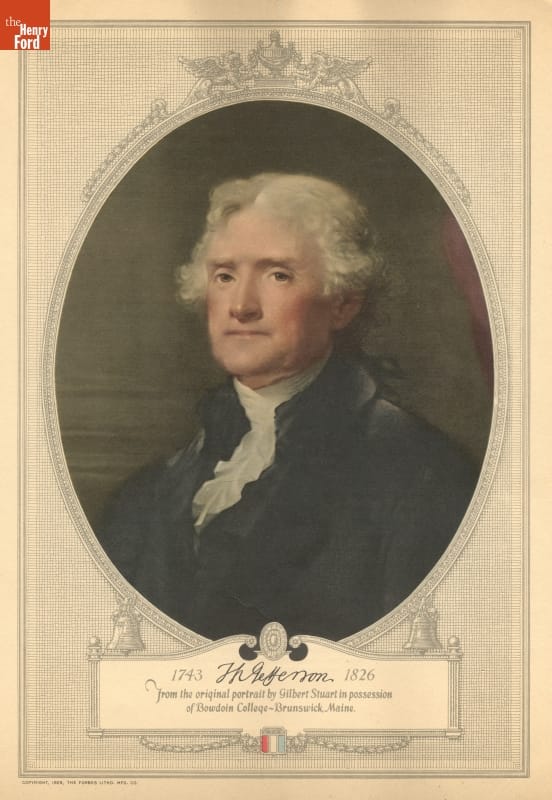
Print of Thomas Jefferson, 1929, based upon original 1805 portrait by Gilbert Stuart. / THF2295
The memorable first portion of the Declaration of Independence is full of soaring rhetoric derived from the Enlightenment ideals that Jefferson favored. The Enlightenment, an 18th-century European intellectual movement, stressed liberty and equality as natural human rights. The words in this first portion of the document were more philosophical and aspirational than the reality—and, indeed, they have lent themselves to reinterpretation and redefinition throughout our country’s history.
The later portion pertained to specific issues of the time. It contained a list of perceived wrongdoings against the colonists for which Jefferson blamed Great Britain’s King George III. These included the king’s repeatedly interfering with the colonists’ laws and ability to govern themselves; his placement of hostile troops in their midst; and his generally acting like a “tyrant” while violating Americans’ rights (for more on colonists’ mounting frustrations, see our post about the Boston Massacre). Nearly 30 charges were railed at King George III in Jefferson’s first draft, all intended to justify the colonists rebelling against him.
Included in this list was a 168-word passage condemning slavery as one of the many evils foisted upon the colonists by the British crown. Jefferson’s inclusion of this “evil” within this context was a tactically shrewd decision. It was easy to blame King George III for the institution of chattel slavery (that is, the buying and selling of people as property) with the rest of the “long train of abuses.” This was a key point of contention between Great Britain and the colonies.
The first part of the so-called “slavery passage” was aimed directly at the King:
He has waged cruel war against human nature itself, violating its most sacred rights of life and liberty in the persons of a distant people who never offended him, captivating & carrying them into slavery in another hemisphere or to incur miserable death in their transportation thither…
The second part of this passage alluded to a 1775 proclamation by British Lord Dunmore, which offered freedom to any enslaved person in the American colonies who volunteered to serve in the British army to fight against the American patriots:
…he is now exciting those very people to rise in arms among us, and to purchase that liberty of which he has deprived them, by murdering the people on whom he has obtruded them: thus paying off former crimes committed again the Liberties of one people, with crimes which he urges them to commit against the lives of another.
Lord Dunmore’s 1775 proclamation indeed inspired thousands of enslaved African Americans to seek liberty behind British lines. It also incensed American patriots. Including a direct reference to this, Jefferson knew, would further rally colonists behind the cause for independence and their commitment to rebellion.
Deleting the Passage
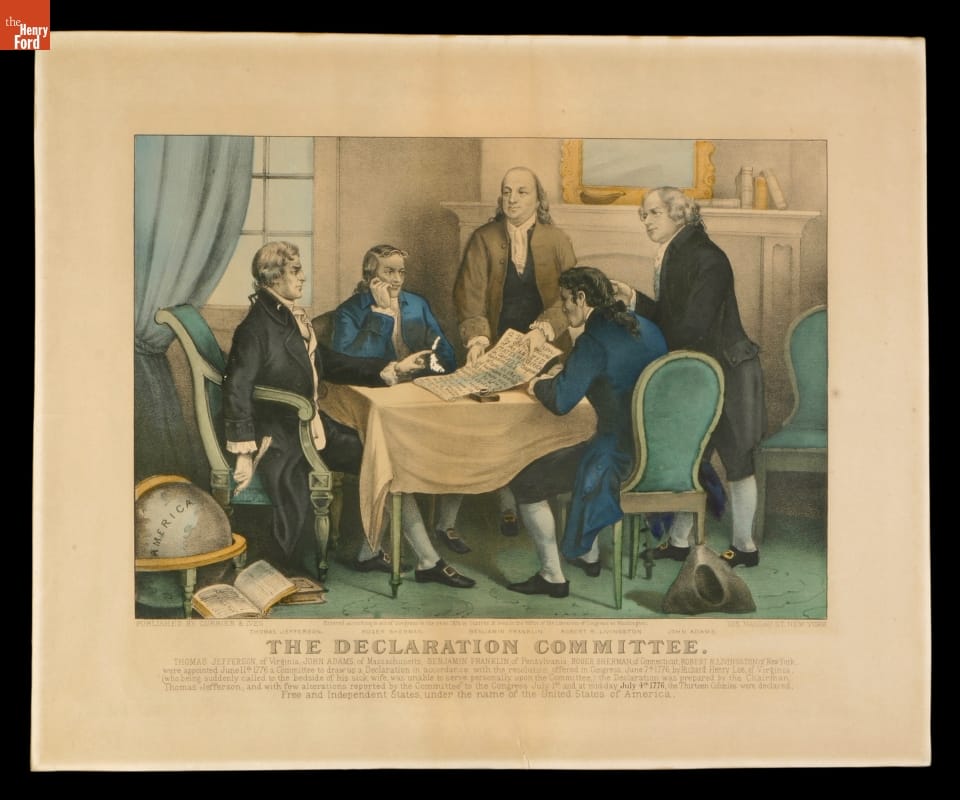
Engraving of members of the “Declaration Committee” reviewing Jefferson’s draft, Currier & Ives, 1876. In addition to Jefferson, this committee consisted of Benjamin Franklin, John Adams, Roger Sherman, and Robert Livingston. / THF97316
After four members of a small sub-committee reviewed Jefferson’s draft, the entire 56-member Second Continental Congress then debated its merits. The exact circumstances of this debate may never be known, as there is no written record of it. We do know, however, that during this debate, the slavery passage was removed.
Why did this occur?
The short answer is that too many delegates, and the colonies they represented, had a vested interest in perpetuating the institution of chattel slavery. Southern plantation owners insisted that they needed free labor to produce tobacco, cotton, and other cash crops for export. Northern shipping merchants depended upon the trans-Atlantic triangular trade of rum, sugar (generally in the form of molasses), and enslaved Africans. At the time, slavery existed in all 13 colonies, and at least one-third of the delegates to the Second Continental Congress (who would go on to become the signers of the Declaration of Independence) owned slaves themselves.
In addition to their own self-interest, the delegates had a larger intent in mind when they deleted the references to slavery in the document. They realized that this manifesto would inevitably lead to war. This document had to convince thousands of colonists to voluntarily risk their lives in a rebellion against the British. The grievances against King George III needed to be ironclad and compelling. They had to unify Americans from 13 very different colonies and from all walks of life. They needed to clearly distinguish friends from enemies. Removing the slavery passage, the delegates felt, helped clarify their arguments and achieve these goals.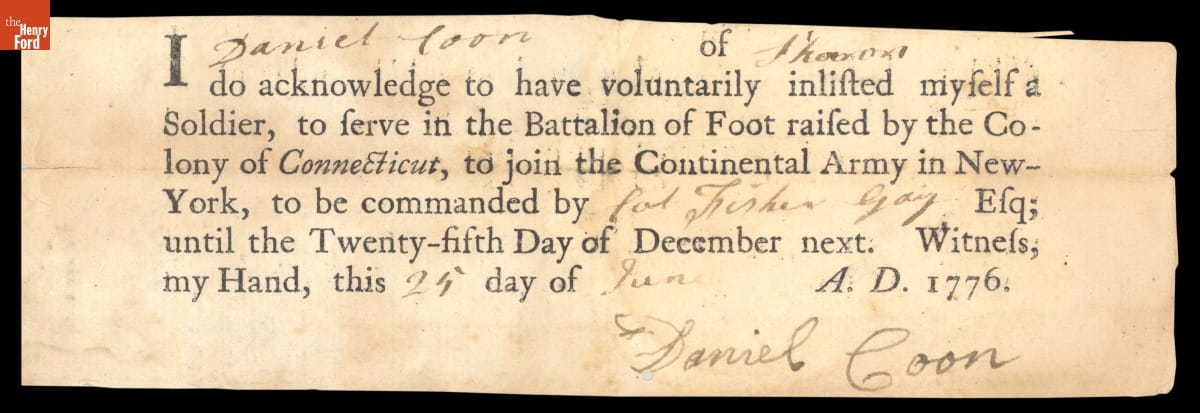
This Connecticut patriot enlisted in the Continental Army just before the Declaration of Independence was formally approved. / THF126080
Finally, there was also a prevailing belief at the time that slavery in America was on the wane—that the general emancipation of slaves was imminent and inevitable. Taking the path of least resistance, the delegates chose not to face this divisive issue head-on. Their delay tactic would not last for long, however, as the issue immediately emerged again during the drafting of the U.S. Constitution in 1787.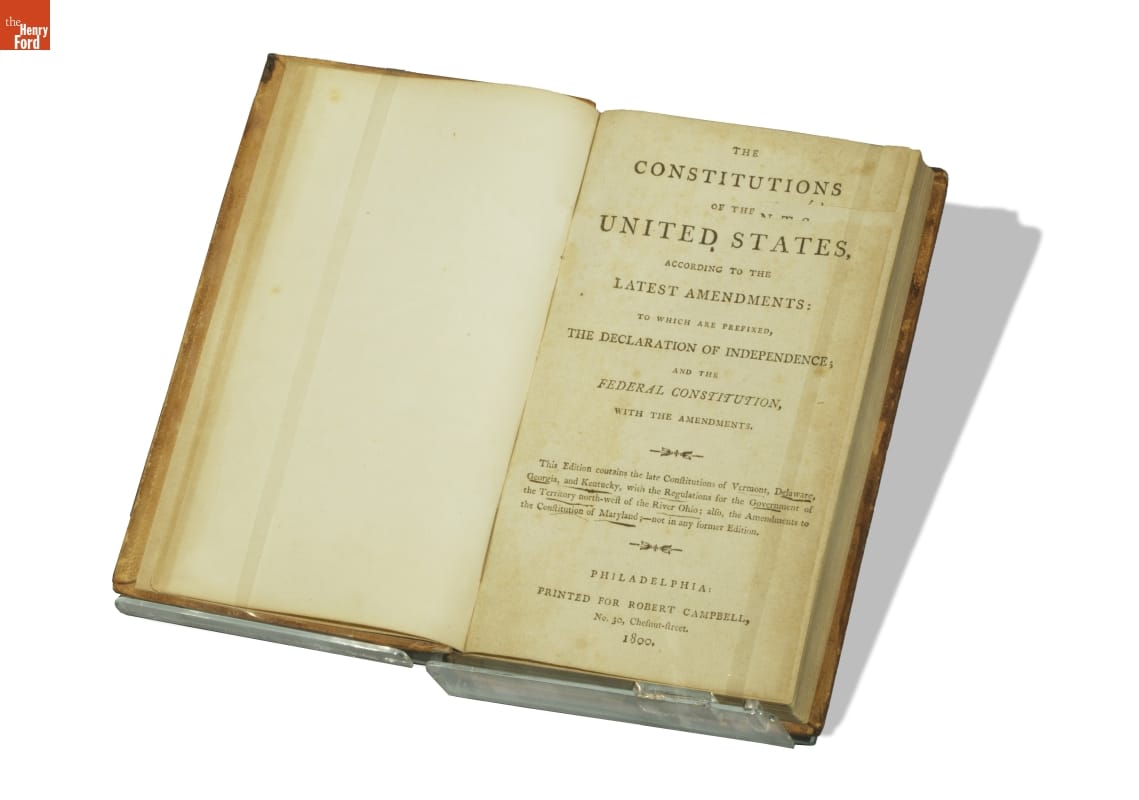
Copy of the U.S. Constitution, a rare survivor from 1800, including the text of the founding documents as well as the constitutions of the 15 then-existing states and the Northwest Ordinance, which regulated the Northwest Territory. / THF155864
In the end, the delegates replaced the deleted slavery clause with a passage that instead highlighted King George III’s incitement of “domestic insurrectionists among us”—a direct reference to the British stirring up, encouraging, and supporting warfare between colonists and Indigenous tribes:
He has excited domestic insurrections amongst us, and has endeavored to bring on the inhabitants of our frontiers, the merciless Indian Savages, whose known rule of warfare, is an undistinguished destruction of all ages, sexes and conditions.
This was a statement, the delegates believed, that the colonists could truly rally behind. They made no more changes after that.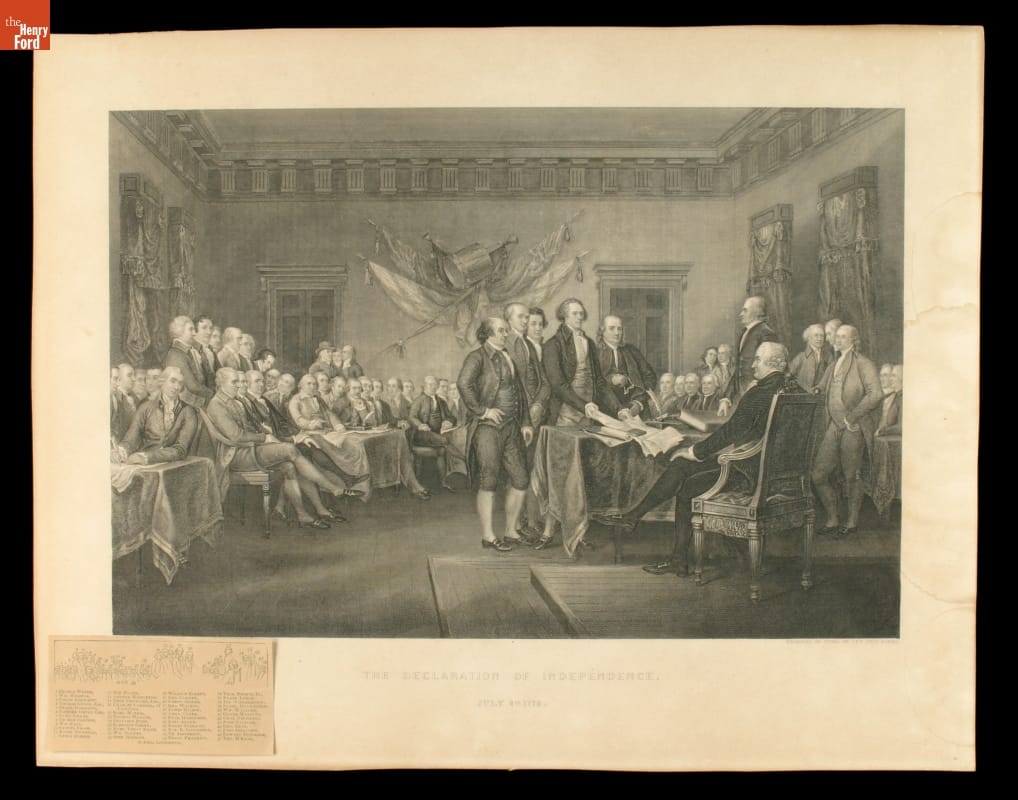
This engraving depicts the June 28, 1776, presentation of the draft of the Declaration of Independence from the five-member Declaration Committee to the entire Second Continental Congress. Engraving made about 1850 by J.F.E. Prud’homme, based upon an 1817 John Trumbull painting. / THF97322
And so, on the fourth day of July, 1776, with the adopted Declaration of Independence in hand, the thirteen American colonies formally declared their independence from Great Britain.
Thomas Jefferson quietly seethed about the changes to his draft of the document, especially the deletion of the slavery passage. He was, in fact, deeply conflicted about the institution of chattel slavery. He understood that his own livelihood depended upon its perpetuation and, over his lifetime, enslaved over 600 people (including his own children by enslaved woman Sally Hemings). At the same time, he bemoaned the existence of slavery and was continually frustrated that he could not extricate himself from its “deplorable entanglement.” As U.S. president in 1807, he passed significant legislation prohibiting the “importation of slaves to any port or place within the jurisdiction of the United States.” But he also suspected that Black people were inferior and supported the popular notion that newly emancipated slaves should leave the U.S. and resettle in Africa or the West Indies.
Impact of the Revised Passage
What the signers of the Declaration of Independence did not realize at the time was that instead of weakening or dying out completely, slavery would become more widespread, profitable, and entrenched in American society. They did not know that slavery would become the central defining problem that would lead to the bloody U.S. Civil War.
The decision to remove the slavery passage and replace it with a passage about “domestic insurrectionists” (i.e., Indigenous tribes) also left a long shadow over the definition of who was considered part of the new republic and who was not—in essence, defining who was an American and who was an outsider (African Americans, both enslaved and free, as well as Native Americans). It consequently ensured that systemic racism against these groups would become as foundational as the American ideal of “life, liberty, and the pursuit of happiness."
The deletion of Thomas Jefferson’s slavery passage in the Declaration of Independence had powerful and far-reaching consequences. Little did the Founding Fathers know that that we would still be feeling those reverberations today.
Donna R. Braden is Senior Curator and Curator of Public Life at The Henry Ford. This blog post is part of a series that sheds new light on stories told within the With Liberty & Justice for All exhibition in Henry Ford Museum of American Innovation.
Henry Ford Museum, presidents, African American history, by Donna R. Braden
Celebrating Lamy’s Diner
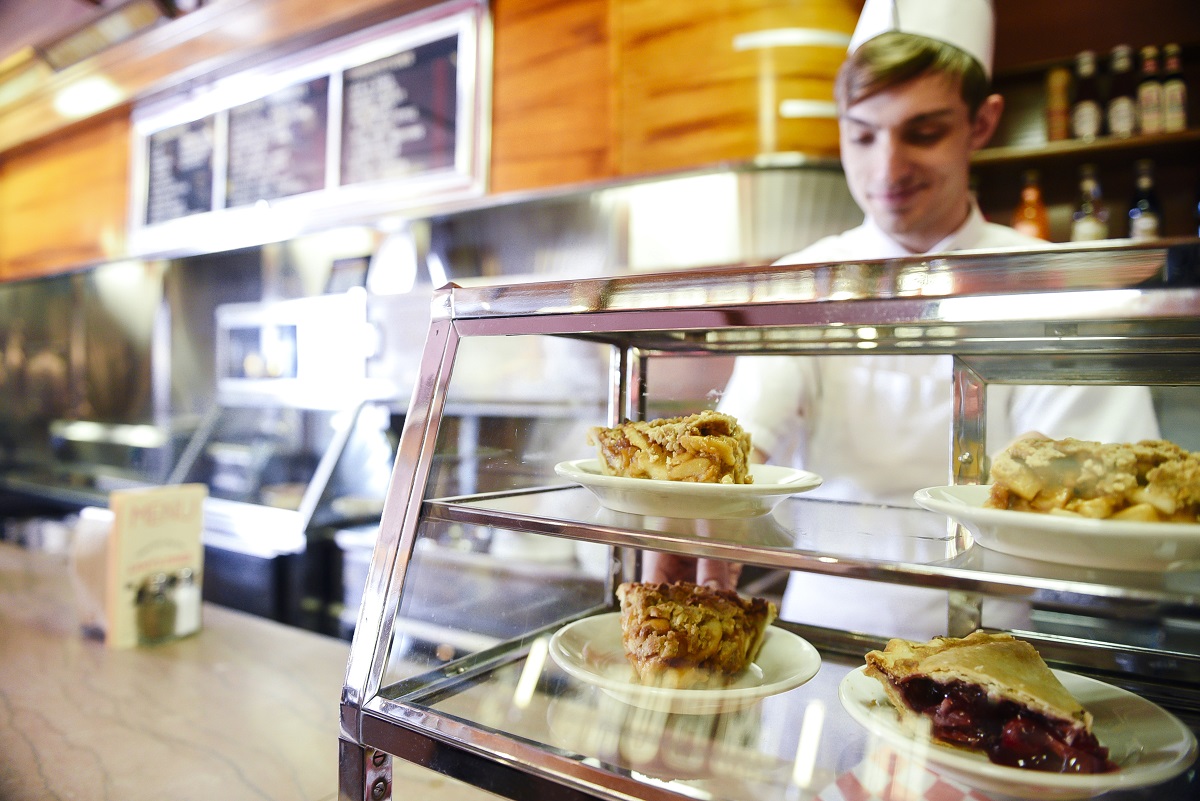 Photo by Emily Berger
Photo by Emily Berger
This month we are excited to reopen a guest favorite inside Henry Ford Museum of American Innovation: Lamy's Diner, a must-stop destination closed for almost two years during the COVID-19 pandemic. Operating as a restaurant inside the museum since 2012, Lamy’s provides members and guests an authentic 1940s diner experience, complete with chicken salad sandwiches and frappes. (And Toll House chocolate chip cookies, of course!)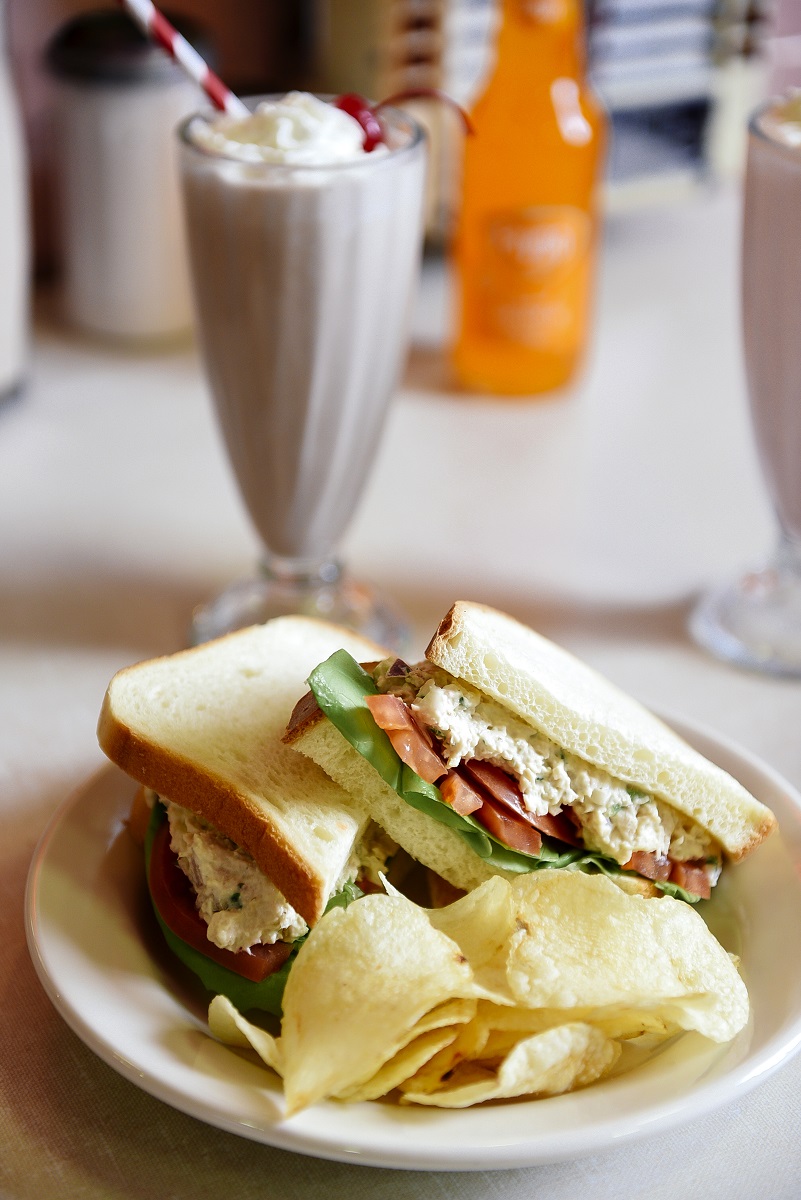
Photo by Emily Berger
In honor of Lamy’s reopening for daily dining, Eric Schilbe, Executive Sous Chef at The Henry Ford, shares two recipes that are crowd pleasers on the menu: tomato soup (an occasional special) and maple chicken salad. Try making these favorites at home, and then dig deeper into all-things Lamy’s in our Digital Collections.
Recipes
Lamy’s Tomato Soup
Makes about 4-5 bowls
Why we use this recipe:This is a very traditional tomato soup that has plenty of vegetable flavor and a touch of richness from the Parmesan cheese. (Psst! Don’t add the cheese until the very end!)
Ingredients
- 2T olive oil
- 1 large onion, diced
- 4 stalks small diced celery
- 2 carrots, chopped
- 1 bay leaf
- 1t dried basil
- 2 large cans diced tomato (plain – no seasoning)
- 1 cup half-and-half
- 1t pepper
- ¼ cup Parmesan cheese
Directions
- Cook the onions, carrots, and celery with oil in a stainless pot until completely tender.
- Add tomatoes, bay leaf, basil, and simmer about 30-40 minutes until completely cooked. (It should be a little darker than when you started.)
- Finish with half and half, Parmesan cheese, and pepper. Remove from heat.
- Using a blender, blend the soup until very smooth, and then serve immediately.
Chef’s Notes
- All canned tomatoes are not created equal! You may need to adjust with a little water or cook them down longer.
- Cook your vegetables until they are completely tender and falling apart—this will add richness to the flavor.
Lamy’s Maple Chicken Salad
Makes about 4-5 sandwiches
Why we use this recipe: Chicken salad can be such a simple recipe, but by adding maple syrup, a classic New England ingredient, and a touch of cumin, we set it apart from others.
Ingredients
- 2 large chicken breasts, cooked and cooled
- 4 stalks small diced celery
- ¼ minced red onion
- 1T yellow mustard
- 1T pure maple syrup
- ¼ cup mayonnaise
- 2T sour cream
- 1/4t cumin
- 1T fresh parsley, chopped fine
- 1t pepper
Directions
- Cook, cool, and pick the chicken. Place in a food processor and pulse until shredded fine.
- Add all other ingredients together and mix well.
- Let set, refrigerated, for 1-2 hours before serving.
Chef’s Notes
- During this era, the chicken was typically shredded very fine and simple ingredients were used. When making this at home, make sure the chicken is not overcooked and that it is very well shredded. This will make the salad moist and flavorful; you can always add a touch more mayonnaise.
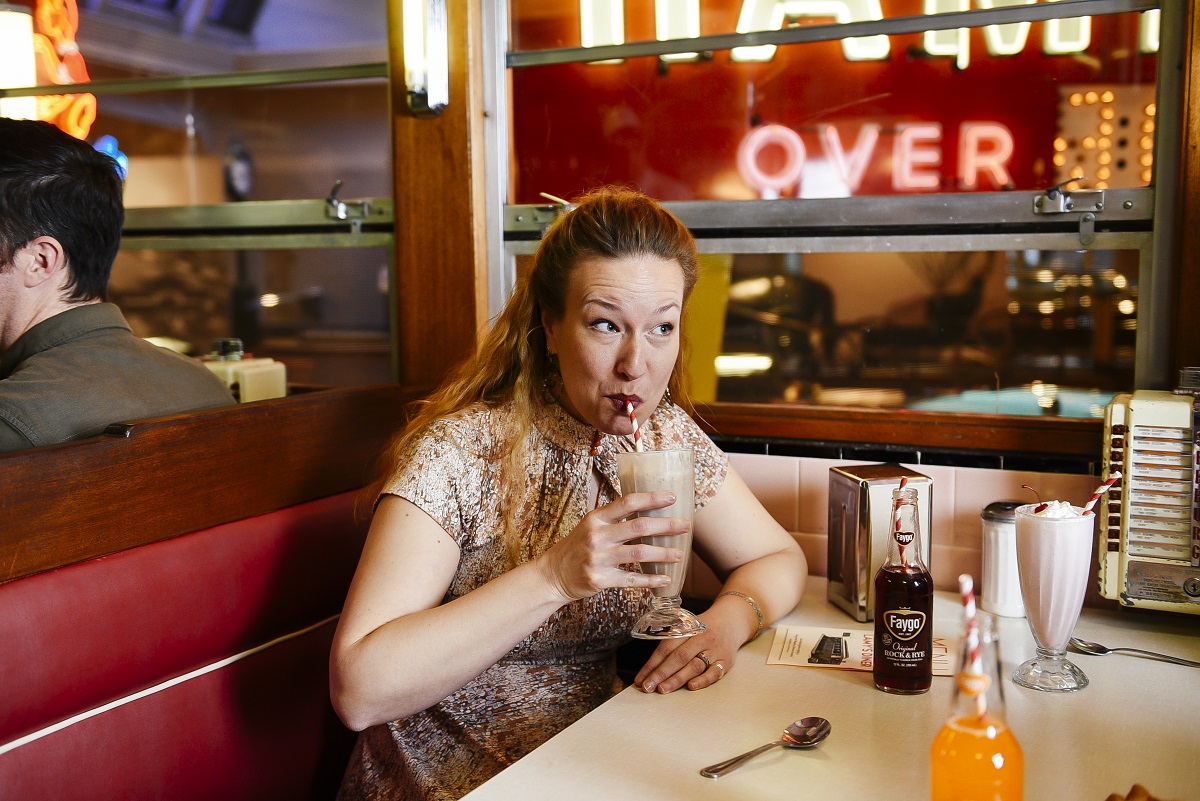
Photo by Emily Berger
Dig Deeper: Lamy's Online
All About Lamy’s
- Plan Your Visit: Lamy’s Diner (find notes on visiting and hours)
- Lamy’s Diner, 1946 (check out the Lamy’s artifact page in our Digital Collections)
- Lamy’s: A Diner from the Golden Age (explore the history of Lamy’s on our blog)
- Lamy’s Gets a Makeover (2017) (learn about our 2017 updates to Lamy’s menu; note that additional changes have been made since)
- Lamy’s on TV: Mr. Coffee – The Henry Ford’s Innovation Nation
Diners, Drive-Ins... and Cookies
- Diners: An American Original (dig into the history of the diner on our blog)
- Dig Deeper: Owl Night Lunch Wagon (explore artifacts related to Greenfield Village’s own Owl Night Lunch Wagon)
- Inventing America’s Favorite Cookie (find out how America’s favorite cookie, the Toll House chocolate chip cookie, was born)
- Flipping Burgers into a Career (learn the story of Don Dunivent, who worked for White Castle from the 1920s through the 1950s)
- Dig Deeper: Lunch Wagons (check out artifacts related to lunch wagons in our Digital Collections)
More Historic Dining at The Henry Ford
- Creating the Eagle Tavern Dining Experience (go behind-the-scenes to learn how we developed the menu for Greenfield Village’s Eagle Tavern)
- Beyond the Peanut: Food Inspired by Carver (discover how agricultural scientist George Washington Carver’s own recipes provided inspiration for some of our recipes at A Taste of History and Plum Market Kitchen)
Lish Dorset is Marketing Manager, Non-Admission Products, and Eric Schilbe is Executive Sous Chef at The Henry Ford.
Additional Readings:
- Lamy's Diner
- Lamy's: A Diner from the Golden Age
- Lamy's Diner at Its Original Site in Marlborough, Massachusetts, circa 1946
- Diners: An American Original
COVID 19 impact, recipes, by Eric Schilbe, by Lish Dorset, food, Driving America, Henry Ford Museum, diners, restaurants
1920 Dayton-Wright RB-1 Airplane

The Dayton-Wright RB-1 is a dramatic presence in Heroes of the Sky. / THF39666
“Racing breeds innovation.” It’s a time-tested saying that we often associate with auto racing, where things like rear-view mirrors and disc brakes proved themselves on the track before making their way into production cars. But that line holds just as true for early airplane racing. The proof is in competition craft like the 1920 Dayton-Wright RB-1.
Above all else, the RB-1 was built for speed. Designers Howard M. Rinehart (the “R” in “RB-1”) and Milton C. Baumann (the “B”) designed the airplane specifically to compete in the 1920 Gordon Bennett Air Race in France. First staged in 1909, the Bennett race was the premier venue for showcasing the latest in aircraft design and aviation technology. The competitions were held annually through 1913, but World War I forced a pause. The 1920 Bennett race, held in Orléans and Étampes, France, marked the first (and, as it turned out, last) running after the wartime hiatus.
Rods and linkages moved flaps that changed the shape of the RB-1’s wing. / THF1463
Rinehart and Baumann gave the RB-1 several features—taken for granted today—that were absolutely cutting edge for the time. To start, it was a monoplane (single wing) design in an age when double wing biplanes dominated. The RB-1’s wing was cantilevered, meaning that it was entirely self-supporting via an internal framework. The wing didn’t require struts or cables to hold it in place. Both the wing and fuselage (the body of the plane) were made from laminated balsa wood covered with plywood and varnished linen. The designers equipped the RB-1’s wing with flaps on the front leading and rear trailing edges. Moving the flaps changed the wing’s camber—the shape of its curve. The flaps hung down during takeoffs and landings to produce maximum lift at low speeds, and they turned up flush with the wing during flight to reduce drag at high speeds.
Notice how the RB-1’s wing flaps and wheels move together. / THF169298, THF169299, THF169300
Rinehart and Baumann realized that the wheels and struts used in an airplane’s landing gear produced significant wind resistance. They solved that problem with a pair of retractable wheels that could be pulled up into the fuselage when the plane was in flight. The RB-1 is believed to have been the first land-based airplane to use retractable landing gear. (Some earlier floatplanes—airplanes equipped with pontoons for water-based operation—had auxiliary retractable wheels.) The RB-1’s wing flaps and wheels were interlocked. When the pilot turned a hand crank on the control panel, the flaps and wheels moved simultaneously—wheels and flaps up after takeoff, or wheels and flaps down for landing.
The pilot’s view—or lack thereof—from the RB-1’s cockpit. / THF15954
Rinehart and Baumann also gave the RB-1 an enclosed cockpit. This further reduced drag, but at a significant cost. The design left the pilot with absolutely no forward vision, and with only limited lateral vision through a set of portholes on either side of the fuselage. The pilot had to fly in a zigzag pattern to see what was ahead.
The RB-1’s specifications were as impressive for 1920 as its appearance. The plane was equipped with an inline six-cylinder, water-cooled engine capable of 250 horsepower. Top speed recorded in competition was 165 miles per hour, but observers at the time thought the RB-1 was capable of 190 or even 200 miles per hour. The airplane measured 22 feet, 6 inches long, with a wingspan of 23 feet, 3 inches. The plane measured 6 feet, 2 inches high at its tallest point. Range was estimated at 275 miles—though that would’ve been cut considerably when flying at top speed.
The Dayton-Wright Company of Dayton, Ohio, built the RB-1. Dayton-Wright had been founded by a group of Dayton-area investors in 1917. Orville Wright served as a consultant to the firm, and he lent it the use of his name, but beyond that Dayton-Wright had no connection to the Wright brothers or their earlier Wright Company. (Wilbur Wright died of typhoid fever in 1912, and Orville Wright largely retired from business a few years later.) General Motors purchased the Dayton-Wright Company in 1919.
Howard Rinehart demonstrates the strength of the RB-1’s cantilevered wing. / THF270970
The work of piloting the RB-1 in the Gordon Bennett Air Race fell to Howard Rinehart. He had learned to fly in 1914 and, by the time the RB-1 project came together, Rinehart’s resume included stints as an exhibition flyer, a flight instructor, and a test pilot. Rinehart was a capable and experienced pilot well suited for the demanding Bennett competition, and the RB-1 was as fine an airplane as one could wish in 1920. When Rinehart took off on race day, September 28, 1920, he was America’s best chance to take the Bennett Trophy back from French pilot Maurice Prevost, who’d won the 1913 contest. But, in the words of poet Robert Burns, “the best-laid schemes of mice and men go oft awry.”
Soon after Rinehart left the ground, the RB-1’s variable wing camber system gave him trouble. He could not get the wing flaps moved into racing position. And because the flaps were interconnected with the wheels, he couldn’t get the landing gear pulled completely into the fuselage either. To make things worse, Rinehart started having problems with the control rod. One of its connecting cables broke, and he found himself unable to turn the plane to the left. After about 20 minutes of struggle, Rinehart brought the RB-1 in for a landing. He touched down safely, but his chance for a victory was gone. Newspapers reported that “there were tears in the pilot’s eyes as he stepped from his machine.”
The Dayton-Wright RB-1, photographed in August 1920. / THF270958
In the RB-1’s defense, mechanical problems were common in racing airplanes of that era. For that matter, technical gremlins continue to haunt racing vehicles of all types to this day—it’s just the nature of the game. The RB-1 never raced again. But in the years to come, its innovative features became commonplace.
Following the disappointment in France, Milton Baumann presented the RB-1 to the University of Michigan, his alma mater. It’s possible that engineering students used the aircraft for hands-on experiments. The university gifted the airplane to The Henry Ford in 1940. Knowing that the RB-1 had been modified several times leading up to the Bennett race, and that students may have made further alterations, museum staff members were eager to return the airplane to its race-day configuration. They turned to Charles Kettering, then the general manager of General Motors’ Research Laboratories Division in Detroit, for advice. Gearheads know Kettering for automotive innovations like the electric starter and leaded gasoline. But he was also one of the Dayton-Wright Company’s founders in 1917, and he was involved in the RB-1 project in 1920.
Today visitors will find the Dayton-Wright RB-1 on display in Heroes of the Sky, where it anchors our collection of early record-breaking aircraft. It may not have won any prizes in 1920, but the RB-1 continues to win admiration from those who see it.
Matt Anderson is Curator of Transportation at The Henry Ford.
Additional Readings:
- 1917 Curtiss JN-4 “Canuck” Biplane
- Neil Armstrong: Reluctant Hero
- The 1929 Women’s “Powder Puff” Air Derby
- Getting into the Air: Alexander Graham Bell’s Aerial Experiment Association
aviators, racing, Heroes of the Sky, Henry Ford Museum, flying, engineering, design, by Matt Anderson, airplanes

“The Night Before Christmas” program at Holiday Nights in Greenfield Village. / Photograph by Amy Nasir.
Guests of Henry Ford Museum of American Innovation and Greenfield Village have been captivated by our various dramatic programs for decades at The Henry Ford. And Anthony Lucas’ performances as an historical actor have been essential in bringing our stories to life throughout many time periods and historical contexts. I had the honor of sitting down with Anthony, 2010 winner of The Henry Ford’s Steven Hamp Award, to chat about his 20 years of theatrical work at The Henry Ford.
You’ve been performing at The Henry Ford since the fall of 2000. What was your first project here?
I started as a replacement actor when another actor was out sick, and I performed in a program called “Gullah Tales” near the Hermitage Slave Quarters. After this, they called me back to do more performances.
How did you get into acting and what inspired you to act?
My interest to become an actor goes back to when I was five years old, believe it or not. I used to watch a gentleman named Bill Kennedy, a local TV host in Detroit who would show a lot of black-and-white Hollywood movies on Sunday afternoons. I would watch actors like James Cagney, and I said in my mind: “Wow, I want to do that!” I have a lot of favorite actors, but James Cagney was the first one because of his energy and his versatility. He could play a lot of different roles other than playing the bad guy. All the movies I watched on Bill Kennedy at the Movies were very entertaining, and they made a big impression upon me, including all the musicals and the films that starred Shirley Temple, Humphrey Bogart, Edward G. Robinson, and Bette Davis—the Golden Age of Hollywood.
What were your first theatrical roles and when did you perform them?
I really didn't get the opportunity to act until at the end of the 11th grade in high school. The following year, I did two plays. One was kind of a historical play dealing with Black history. It was called “In White America,” and it was a series of vignettes and monologues about civil rights and the Black struggle for freedom in the United States. And the other play was a kind of comedy farce called “Day of Absence.” The story took place in the South, and it dealt with what would happen if one day all the Black folks had suddenly disappeared. My performances took place in the early 1970s. We were coming right out of the sixties with the civil rights movement and the Black power movement. And so that was my start. I went on to study theater at Western Michigan University and performed in various shows with Detroit Repertory Theatre and Plowshares Theatre Company.
“Elijah: The Real McCoy” program in the museum. / Photograph by Kristina Sikora (KMS Photography)
You’ve performed in several programs at The Henry Ford, which we’ll get into in a moment. But first, which one stands out as your favorite?
I love all the shows that I do, but one of my most favorite programs is “Elijah: The Real McCoy,” which I performed in both the village and museum. Elaine Kaiser, who has since retired [as Manager of Dramatic Programs at The Henry Ford], wrote it brilliantly. She wrote it for me to perform at Discovery Camp. Every show was very rewarding, and I just loved working with the kids during camp and seeing them at shows. The story starts with Elijah McCoy as a young kid, and the scenes travel through his achievements and struggles until he reaches his success as an inventor, and then into his old age. I loved to perform each stage of his life and see the kids’ reactions.
Photograph by Kristina Sikora (KMS Photography)
Have there been any challenges you’ve encountered while performing?
Well, here’s a story that’s kind of funny. One summer in the village, I was very busy. While I was at Town Hall doing a couple of Elijah McCoy shows, I would need to change into a different period costume and get to Susquehanna Plantation to do “North Star Tales” as fast as I could. And then I would hurry up and go back to Town Hall, change, and do another Elijah McCoy. Thankfully, Elaine Kaiser loaned me her bike, so I could ride it between shows. So, it was quite exciting!
“How I Got Over” program at Susquehanna Plantation. / Photograph by Roy Ritchie
I’ve attended your performances at Susquehanna Plantation many times and have always been inspired when participating with other guests as we jumped from the porch steps yelling, “Freedom!” How long have you been performing at Susquehanna, and are there any other similar programs you perform in?
There were a few different shows we did at Susquehanna, and they go back to 2003, right after the renovation of the village. There is “How I Got Over,” “Tally’s Tales,” and a newer version called “North Star Tales,” which were all themed around the stories of slavery and endurance on the plantation. Last year in 2021, I narrated the North Star Gospel Chorale’s performance on the porch of Susquehanna as part of Salute to America: Summer Stroll. That was the first year, and it was really a great experience. We really enjoyed that. It's really a powerful show and I was happy to be a part of that. The Chorale also performed in the museum in February 2020, right before the pandemic, which was livestreamed on Facebook.
“I’ve Seen the Mountain Top” speech at National Day of Courage in the museum. / Screenshot from YouTube
You are also a big part of the “Minds on Freedom” program in the museum. When did that start and how did it develop?
Yes, this program started in 2004, and it was a combination of two shows—a musical act, and then a dialogue part about the Civil Rights Movement. It was merged into one show called “Minds on Freedom,” which was performed in the museum around our Celebrate Black History program in February. There was also our special celebration of the Emancipation Proclamation in June 2011, which I enjoyed being a part of. And during the National Day of Courage, celebrating Rosa Parks’ 100th birthday on February 4, 2013, I performed Martin Luther King, Jr.’s “I’ve Seen the Mountain Top” speech. That's always an honor any time I get a chance to express the words of Dr. King. He was a great man, a great orator, a great minister, and a great leader. And he gave his life for us to believe them. So any time you try to deliver his speeches, you’re never going to be like Dr. King. But I use my own approach and try my best to get the spirit across.
“Elijah: The Real McCoy” program in the museum. / Photographs by Kristina Sikora (KMS Photography)
Many guests are familiar with your performances at our Hallowe’en in Greenfield Village and Holiday Nights in Greenfield Village events. How and when did these roles begin?
Oh, yeah, performing “The Tell-Tale Heart” by Edgar Allen Poe goes way back with me, because it was one of the first dramatic readings I recited in high school. My mother coached me. I think if my mother had pursued acting, she may have been a pretty good actress. She helped me bring the story to life. Around 2003, Elaine Kaiser asked me to dramatize this short story for Hallowe’en from the point of view of a murderer descending into paranoia, haunted by the thumping sound of the murdered man’s heart. The program is different from Holiday Nights, because I have set times for shows. So I usually don't have a chance to interact with the audience in-between shows as much as I would like. Interacting with the audience afterwards whenever possible is a special part of being there. I'm not there just because I'm an actor to do shows. I'm there to be a part of The Henry Ford and to interact with the guests and help create that experience for them. It’s very special, unique, and moving to interact with the guests. So that's how I approach it.
I started performing at Holiday Nights just before I performed at the Hallowe’en event. Initially around 2003, I was working with a few other actors, and we were moving around the village doing a variety of poems and Christmas carols. And it was around 2004, I performed Clement Clarke Moore’s “A Visit from Saint Nick,” which we generally call “The Night Before Christmas.” I performed it as a solo act and was relocated outside of Town Hall and later to a warming fire. It’s developed into a very special event because of how guests react. There was one guy who proposed to his girlfriend at my warming fire. There are so many people with stories of their own, making Holiday Nights and the village a big part of their lives. Holiday Nights is a whole story in itself. I started adding an introduction to the performance rather than just solely dramatizing the poem. I started talking about Christmas in early America. And then I would ask guests about all the different holiday foods and dishes they like, and finally I would ask: Do you like Christmas cookies? I would then ask the big question: Do you have any with you tonight?
After this, guests started bringing me Christmas cookies every year. I come home with all sorts of cookies, sugar cookies, and chocolate chip cookies and all. Oh, yeah, it's funny. But it's great, though, because people come year after year and sometimes they tell me they used to bring their children and now they're all grown up. I'm like, wow, this is a reminder of how long I've been doing it. And it's so rewarding; sometimes I look out and see people that are moved. They get emotional and so it's wonderful. And the children are the best, they can just make you feel like a million bucks. In December 2020, I recited “The Night Before Christmas” for a video during the pandemic. That was a real different take on it because they had me come in and sit down and have a storybook in my hand. So I had to rework it so it could fit that format. And I like that too. It was very comfortable and warm. That was a real nice change of pace.
“The Tell-Tale Heart” program at Hallowe’en in Greenfield Village. / Photograph by Kristina Sikora (KMS Photography)
Do you have any other stories about interacting with guests you’d like to share?
Sure. I was performing Elijah McCoy at the Town Hall one day, and there is a point where I would walk up the steps of the stage. I was playing the elderly Elijah, and I asked for volunteers from the audience to help me up the steps. So, this one little girl came up to me and she said: your tie is crooked. And she starts straightening my tie. Sometimes you just have to roll with it. That was a beautiful moment.
Another time, there was this couple that followed my shows. They took pictures of me performing Elijah McCoy in the village and “Minds on Freedom” in the museum, and other performances. The wife put together a scrapbook of their photos, and it had all these pictures and a beautiful cover. They gave it to me as a gift. I was just so speechless, you know, that they took time to create it over several months, putting this book together. I was very moved by it.
Amy Nasir is Digital Marketing Specialist and former Historical Presenter in Greenfield Village at The Henry Ford.
Michigan, Dearborn, 21st century, 2020s, 2010s, 2000s, The Henry Ford staff, Holiday Nights, Henry Ford Museum, Hallowe'en in Greenfield Village, Greenfield Village buildings, Greenfield Village, events, Civil Rights, by Amy Nasir, African American history, actors and acting, #Behind The Scenes @ The Henry Ford
Celebrity Sightings from Our Archives

Edsel Ford, Charlie Chaplin, and Henry Ford Touring the Ford Motor Company Highland Park Plant, October 1923 / THF134659
Every month, staff from our library and archives select some interesting items from our collections to showcase on The Henry Ford’s Instagram account. In our every-first-Friday History Outside the Box offering, our collections experts share photographs, documents, and other artifacts around a given theme. Last summer, Reference Archivist Kathy Makas showcased some celebrity sightings from our archives—actors, actresses, and other luminaries visiting Ford Motor Company’s factories, World’s Fairs, and The Henry Ford’s own campus; showcasing their cars; and more. If you missed the Insta story, you can check out the presentation below.
Continue Reading
20th century, travel, Michigan, Dearborn, world's fairs, History Outside the Box, Henry Ford Museum, Greenfield Village, Ford Motor Company, cars, by Kathy Makas, by Ellice Engdahl, archives, actors and acting
A Sort-of-Traditional New Year’s Day Tradition
In preparing for our temporary exhibit Light and Joy in the Holiday Season, The Henry Ford’s curators solicited artifacts, photographs, and stories from The Henry Ford’s staff, among others. Below is one of the stories that was shared for the New Year display case.
My personal, vegetarian version of hoppin’ john, a traditional Southern New Year’s Day meal, in 2013. / Photo courtesy Ellice Engdahl
Though I’ve now lived in metro Detroit for more than two decades, I spent my formative years in the South, growing up in Jacksonville, Florida—the largest city (in terms of square footage) in the contiguous United States, an area split by one of the few rivers in the country that flows north (the St. John’s), and the hometown of Lynyrd Skynyrd.
Neither of my parents were born in Jacksonville. My dad grew up in Pennsylvania, and my mom on Lookout Mountain in the small town of Fort Payne, Alabama. During the Vietnam War, my dad was drafted into the military and sent to Fort McClellan in Anniston, Alabama, to utilize his newly minted bachelor’s degree in architecture to work on base buildings. At that time, my mom was living in Anniston with her sister and her sister’s husband, who was also involved in architecture on the base. My parents met, secretly eloped, moved briefly to Pennsylvania after my dad was discharged, then moved to Jacksonville for a job opportunity for my dad just after I was born.
Being as close to Georgia as you can be and still be in Florida, Jacksonville is definitely the South—the “Bold New City of the South,” as police cars and road signs proclaimed. And Southern foodways predominated, even as economies and cultural traditions slowly became more global. My mother was a fantastic cook who combined her Alabama farm roots with Jacksonville’s traditions—I grew up eating fried okra, grits, redeye gravy, barbecue, boiled peanuts, greens, banana pudding, scuppernongs and muscadines, sweet tea, and pecan pie, and didn’t realize these things weren’t universally beloved, valued, or available until I moved to Michigan.
Greens are a common food in the South. Here, collard greens are de-spined and washed for use in hoppin’ john, 2011. / Photo courtesy Ellice Engdahl
One thing I don’t remember ever not having on New Year’s Day was hoppin’ john. The traditional version of the dish is black-eyed peas cooked in broth with onions and a bit of ham or pork, served over rice, often with greens and cornbread on the side. (We Southerners like our carbs.) I don’t know when or where my mother picked up the idea of serving hoppin’ john on New Year’s Day—one of my cousins did not know what hoppin’ john was when I asked her this year, so I am guessing it did not originate in Alabama. She may have learned about it from friends in Jacksonville who followed the tradition.
The reason this humble staple is eaten on New Year’s Day is for good luck—the greens are the color of money, the peas represent coins, and some people even say the color of the cornbread relates to gold. Some long-time family friends from Jacksonville still refer to their annual plate of hoppin’ john as their “luck and money.” But beyond that, it’s a cheap, filling, and delicious meal.
As near as I can recollect, my mom made it fairly traditionally. She might have thrown a hambone into the peas for extra flavor—at least, before I became vegetarian. After I became vegetarian, she would cook a tray of bacon separate from the peas, so that the meat-eaters in the family (e.g., everyone but me) could crumble some over to get their pork fix, while I could eat meat-free, or crumble on some vegetarian bacon.
Soaking black-eyed peas to use in hoppin’ john, 2011. / Photo courtesy Ellice Engdahl
When I moved to Michigan, I wanted to continue the tradition with a meat-free version, but also wanted to simplify preparation—cooking peas, rice, and greens all separately, along with cornbread, is a lot of work for one person, especially given that it is most delicious when it all gets mashed together on the plate in the end anyway.
My family tended to like our hoppin’ john peas on the soupy side—something in keeping with the Southern tradition of “pot likker,” where you eat the flavorful broth that forms when you cook vegetables in seasoned water. I also took inspiration from another simple dish my mother made often—“bean soup.” This was just dried beans (pretty much any kind) cooked with onions in broth until they were tender and beginning to fall apart. It might sound dull, but cooked slowly for a couple of hours, and finished with a substantial amount of butter…. Yum. Once it was clear a soup was the simplest way to go, it was a pretty easy logical next step to add the greens right into the soup, removing the hassle of cooking them separately.
Cooking a big batch (for eating and for freezing for later) of my version of hoppin’ john, 2015. / Photo courtesy Ellice Engdahl
Below is the recipe (insomuch as I have one) I came up with.
Vegetarian Hoppin’ John (Soup)
Ingredients:
1 lb. dried black-eyed peas
1-2 onions
1-2 bunches collard greens
Vegetable stock, broth, or bouillon
Butter
Vegetarian bacon (I use MorningStar Farms Veggie Bacon Strips)
Preparation:
Pick through the dried black-eyed peas carefully, discarding any brown ones and any stray pebbles. (In my experience, every bag of dried peas contains at least one rock. Though picking through them is tedious, it’s far better to find the pebble(s) with your fingers than your teeth.) Rinse the peas in a strainer, then add them to a large bowl and cover them with a lot of water. Cover the bowl with plastic wrap or foil and let the peas soak overnight. They will grow in size substantially, maybe double.
When you’re ready to make the soup the next day, drain the peas, discarding the soaking water, and rinse them again.
Chop the onions and sauté them in a stockpot in some of the butter until partially softened, then add veggie stock and the soaked peas. Bring to a boil, then reduce to a simmer. Cook until the peas are nearly soft, stirring from time to time, usually one to two hours.
While the peas are cooking, de-spine, wash, and chop the collard greens into bite-sized pieces. When the peas are about half to three-quarters cooked, add the greens to the stockpot, and continue cooking until they are tender. Add additional butter to the soup to taste. (You could also add salt/pepper if desired, but usually the vegetable broth adds plenty of both.)
Cook the veggie bacon according to package directions. Serve up the soup, and crumble a strip or two of veggie bacon on each serving. Enjoy!

The finished product, vegetarian hoppin’ john soup, in 2011. / Photo courtesy Ellice Engdahl
Cornbread on the side is pretty much required. My mom made her own dry mix, which she combined with milk, eggs, and (if vegetarians weren’t present) bacon grease to bake, but since I don’t have her recipe, I just (somewhat shamefully) use the one off the back of the Quaker cornmeal package—though I use less sugar, replace the cow’s milk with plant-based milk, and replace the oil with melted butter—so I guess I’ve modified that as well.
I always make a double batch of hoppin’ john and cornbread and stash the remainder in the freezer to get me through the rest of the cold Michigan winter. It just gets better as you reheat it and the flavors continue to meld.
Snowy Michigan on New Year’s Day, 2014. Hoppin’ john freezes really well so it’s wise to make enough to get you through a Michigan winter. / Photo courtesy Ellice Engdahl
Vegetarian hoppin’ john (soup) might not be the most common tradition, especially in Detroit—but it’s a sign of the times that you can find a vegan version today at Detroit Vegan Soul. But the most satisfying version is the one you make yourself—and make your own.
Ellice Engdahl is Digital Collections and Content Manager at The Henry Ford.
20th century, Michigan, Florida, 21st century, 2010s, recipes, home life, holidays, Henry Ford Museum, food, by Ellice Engdahl
Architect of the Everyday: Designer Michael Graves

Arch Alarm Clock, Designed by Michael Graves, 1999 / THF179673
In 2019, The Henry Ford acquired Michael Graves Design’s extensive product design archive as part of its permanent collection—more than 2,500 objects in total. The Michael Graves Design archive consists of finished products, models, prototypes, and production samples representing partnerships with Alessi, Target, Stryker, Disney, Steuben, Swid Powell, Sunar, Lenox, Dansk, Duravit, and Dornbracht, among others.
“In its entirety, the Michael Graves Design product archive tells a 39-year history of art, culture, and commerce, along with countless stories about the power of design,” said Patricia Mooradian, president and CEO of The Henry Ford. “We are honored that the team chose The Henry Ford as the location to house this collection that shows that everyday products can be designed with both purpose and playfulness.”
This coach's whistle teakettle was designed by Michael Graves for Target in 1999. / THF179699
Graves’ first designs for Target debuted in 1999. The collaboration eventually brought over 2,000 products to market across 20 categories, including kitchen electrics, gadgets, cleaning supplies, home décor, and storage and organization. This groundbreaking 15-year partnership with Target transformed mass-merchandising strategies, elevated consumers’ expectations for design, and made Target a design destination.
In addition to high-end client relationships, Michael Graves Design’s revolutionary approach to common home products, known as “Art of the Everyday Object,” solidified it as a pioneer in the contemporary design industry.
Toilet brush designed by Michael Graves. / THF179683
“Michael Graves and his designers performed a kind of design alchemy, transforming often humble things—thousands of them—into objects of delight, humor, and elegance,” said Marc Greuther, vice president, historical resources and chief curator at The Henry Ford. “He showed that seeming near-opposites, such as practicality, whimsy, affordability, decoration, and modernity, could actually coexist—and move swiftly off the shelves of everyday retailers.”
Continue Reading
home life, shopping, design, The Henry Ford Magazine, by Jennifer LaForce, Henry Ford Museum

